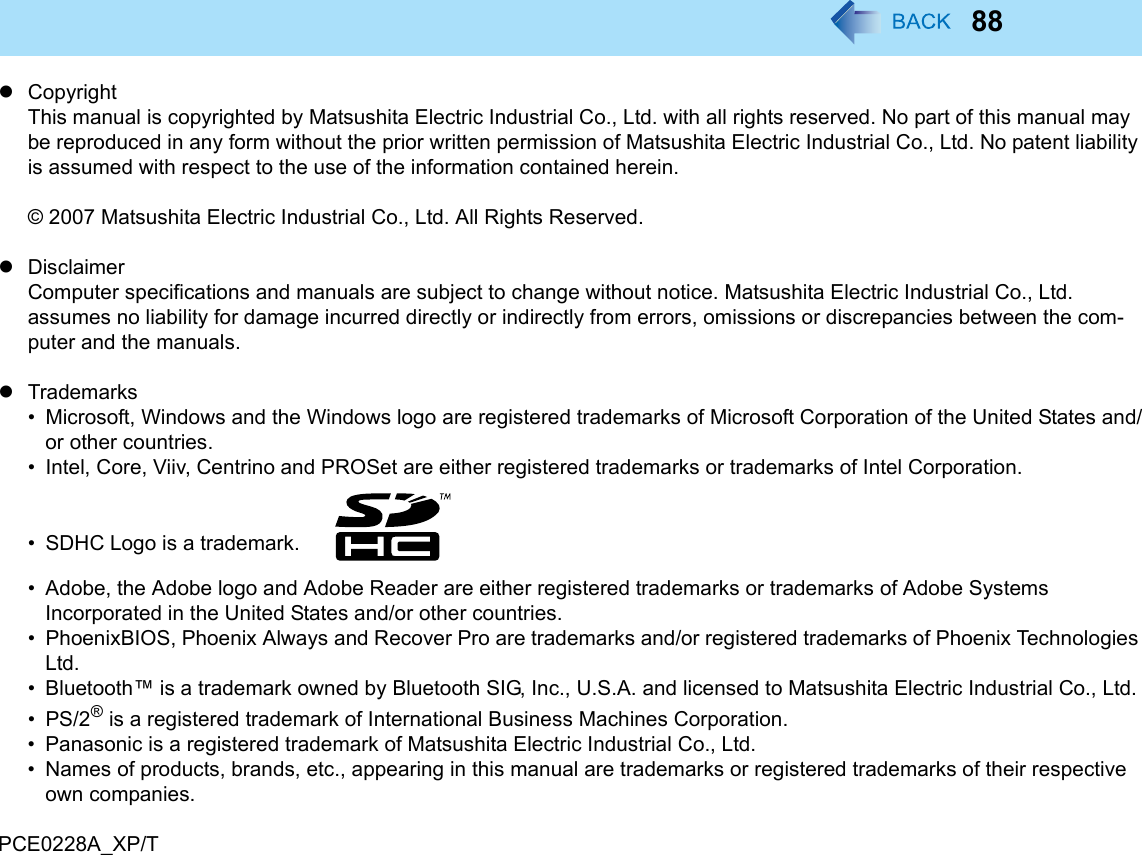Panasonic of North America 9TGCF-198 Laptop Computer Model CF-19 Family User Manual Reference Manual
Panasonic Corporation of North America Laptop Computer Model CF-19 Family Reference Manual
Contents
- 1. Reference Manual for CF 19
- 2. User Manual for CF 19
- 3. Reference Manual CF 19
- 4. User Manual CF 19
- 5. Operation Manual for WLAN
Reference Manual for CF 19
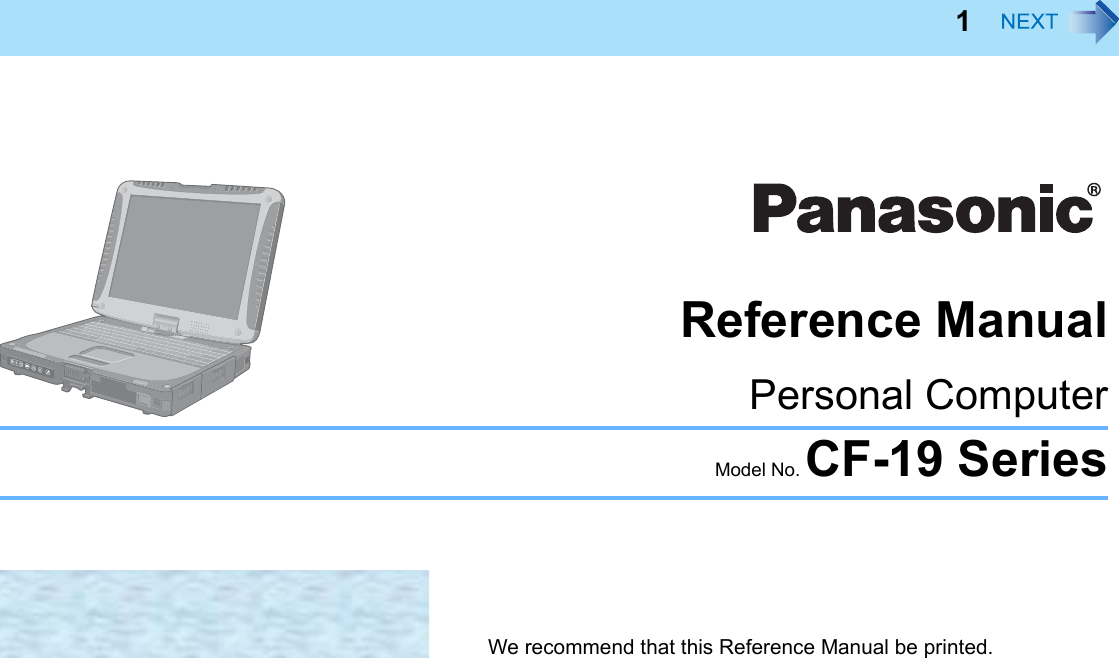
![2Key CombinationsNOTEzDo not repeatedly press the keys in quick succession.zDo not use the key combinations together with touch pad (external mouse), touchscreen (only for model with touch-screen), digitizer (only for model with digitizer), tablet buttons, or other key operations.zDo not use the key combinations before you log on to Windows. Wait until the hard disk drive indicator turns off. On the Setup Utility screen, you can use the key combinations of Fn+F1, Fn+F2 and Fn+F3.zThe key combinations may not work with some applications.zThe popup menu icon appears after logging on to Windows. It may not appear in some application conditions (e.g., when [Command Prompt] is set to “Full Screen”).Key Function Popup menu iconFn+F1Fn+F2LCD brightness(Fn+F1= down / Fn+F2= up)Fn+F3Display switching (Îpage 45)(When an external display is connected)Internal LCD Simultaneous display External displayCAUTIONzDo not press any keys until the display has finished switching.zDo not use this function:• When an external display is not connected.• When playing motion video such as DVD or MPEG.• When using the Extended Desktop.• When showing a game screen such as pinball.zUntil Windows startup is completed (during Setup Utility, etc.), the simulta-neous display cannot be used and pressing Fn+F3 switches the display between the internal LCD and the external display.](https://usermanual.wiki/Panasonic-of-North-America/9TGCF-198.Reference-Manual-for-CF-19/User-Guide-881153-Page-2.png)
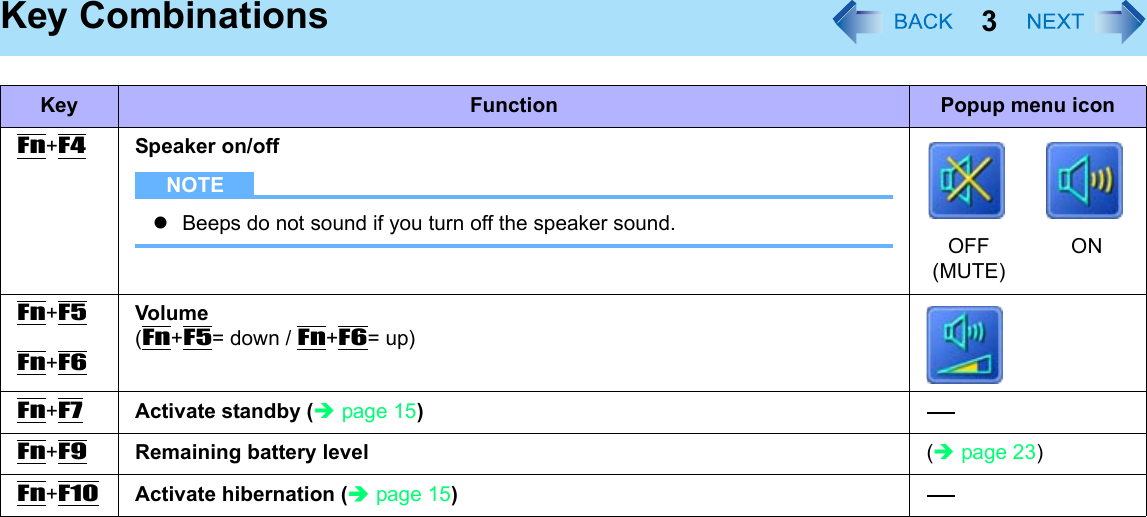
![4Key CombinationsYou can make two settings:•Fn key lockFn is locked (pressed-down) until you press another key. Use this when pressing difficult key combinations.• Popup menu icon on/off1Start up the Hotkey Settings.Click [start] - [All Programs] - [Panasonic] - [Hotkey Settings].2Make the settings.[Use Fn key lock]zWhen using an Fn key combinationAPress Fn once. (Locked)BPress another key. (Lock released)zWhen using successive Fn key combinationsAPress Fn twice. (Locked)BPress another key.Fn key remains locked until you press Fn again.[Notification][Make sounds when Fn key is pressed]*1[Show status on screen]: Displays the Fn key status on the notification area.•: Fn is locked.•: Fn is not locked.[Disable popup]The popup menu icon will not be displayed.3Click [OK].NOTEzYou can have different settings for each user.*1 If the speakers are muted, beeps do not sound.Hotkey Settings](https://usermanual.wiki/Panasonic-of-North-America/9TGCF-198.Reference-Manual-for-CF-19/User-Guide-881153-Page-4.png)
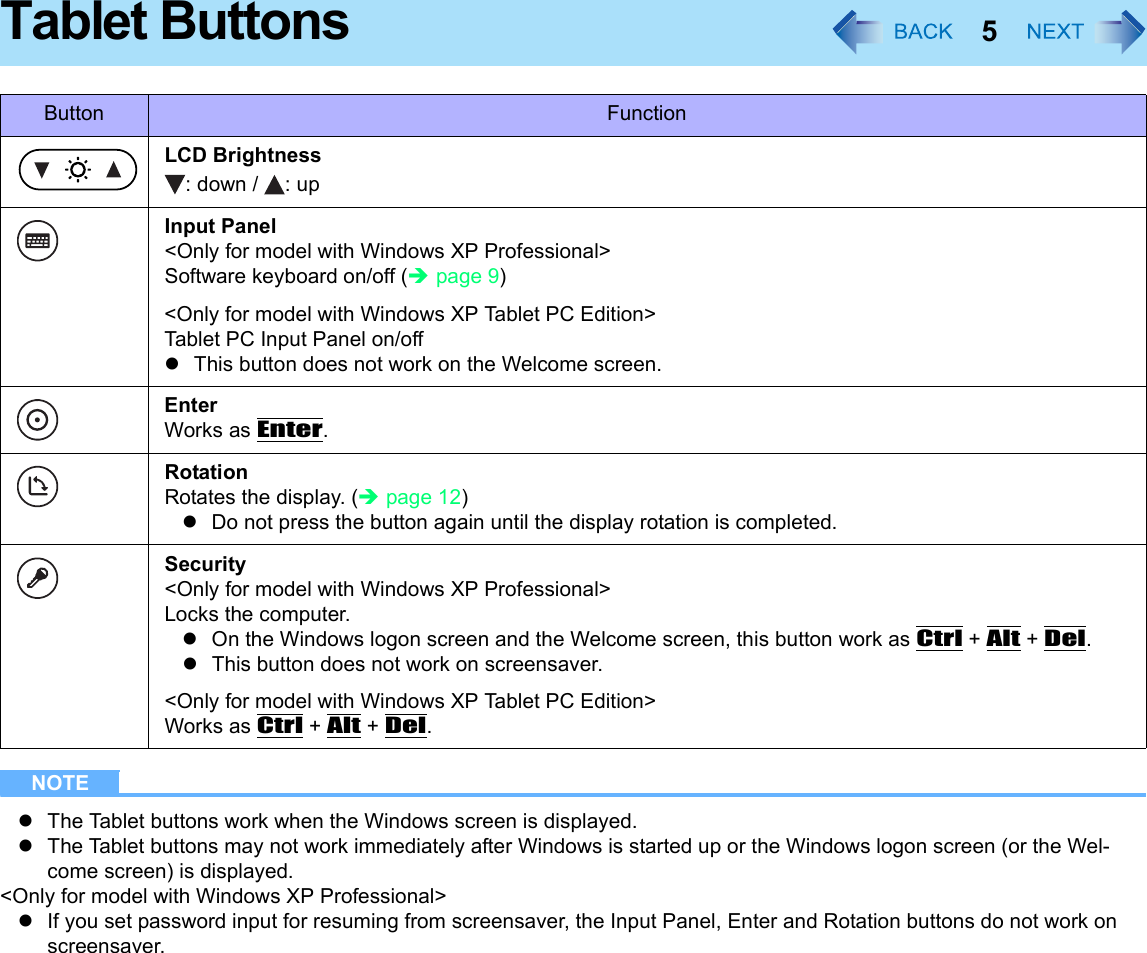
![6Tablet ButtonsNOTEzYou can have different settings for each user.zOn the Windows logon screen and Welcome screen, the tablet buttons are enabled and work in default irrespective of the settings you made.To change the tablet button functionsYou can change the functions of the Input Panel ( )/Enter ( )/Rotation ( ) buttons. 1Open the setting screen.<Only for model with Windows XP Professional>Click [start] - [All Programs] - [Panasonic] - [Tablet Buttons Settings].<Only for model with Windows XP Tablet PC Edition>Click [start] - [Control Panel] - [Printers and Other Hardware] - [Tablet and Pen Settings] - [Tablet Buttons].2Click the tablet button and click [Change].3Select the function in [Action].zYou cannot select Fn for [Press a key or key combination].zClick [Browse] to select the application if you select [Launch an application].4Click [OK].5Click [OK].<Only for model with Windows XP Professional>To disable the tablet buttonsYou can disable the Security ( )/Input Panel ( )/Enter ( )/Rotation ( ) buttons.1Click [start] - [All Programs] - [Panasonic] - [Tablet Buttons Settings].2Remove the check mark from [Enable Security, Input Panel, Enter, Rotation Button.]3Click [OK].Setting the Tablet Buttons](https://usermanual.wiki/Panasonic-of-North-America/9TGCF-198.Reference-Manual-for-CF-19/User-Guide-881153-Page-6.png)
![7Touchscreen<Only for model with touchscreen>You can use the touchscreen function to perform the same operation as the touch pad and mouse. Touch the screen surface with the stylus (included).zTo right-clickAClick on the notification area. changes to .BClick the object you want to right-click. returns to .NOTEzDo not touch the screen by hand or other object when you input using the stylus (included). Otherwise you may not be able to input correctly.zYou need to make the following setting for each user.AClick [start] - [All Programs] - [Fujitsu Touch Panel (USB)] - [Touch Panel Configuration].BSelect the settings, and then click [OK].zDo not add a check mark to [Delete Cursor] since the display may be distorted.zIf you add a check mark for [Use] in [Hold [Ctrl] key down + Touch the screen] of [Touch Panel Configuration], touching the screen may always be recognized as a right-click. To return to the normal operation, press Ctrl on the keyboard.zThe touchscreen function does not work in the Setup Utility, in the full screen of [Command Prompt], or in Recover Pro (Îpage 77).1Run [Touch Screen Calibration Utility].Click [start] - [All programs] - [Fujitsu Touch Panel (USB)] - [Touch Screen Calibration Utility].2Using the stylus, touch each of the 12 “+” target marks one by one until it blinks, and then press Enter.3Press Enter.NOTEzReturn the rotated display to [0 degree] (Îpage 12) before the touchscreen calibration.zPerform the touchscreen calibration for each user.Touchscreen Calibration](https://usermanual.wiki/Panasonic-of-North-America/9TGCF-198.Reference-Manual-for-CF-19/User-Guide-881153-Page-7.png)
![8Digitizer<Only for model with digitizer>You can use the digitizer function to perform the same operation as the touch pad and mouse. Touch the screen surface with the pen (included).For further information, click [start] - [All Programs] - [Get Going with Tablet PC].zTo right-clickAPress and hold the button (A) of the pen, and then tap the object.NOTEzThe digitizer function does not work in the Setup Utility, in the full screen of [Command Prompt], or in Recover Pro (Îpage 77).1Run [Tablet and Pen Settings].Double-click or click [start] - [Control Panel] - [Printers and Other Hardware] - [Tablet and Pen Settings].2Click [Settings] - [Calibrate].3Using the pen, touch each of the four “+” target marks one by one, and then click [OK].zPerform the calibration for both [Landscape] and [Portrait].NOTEzPerform the digitizer calibration for each user.Digitizer Calibration](https://usermanual.wiki/Panasonic-of-North-America/9TGCF-198.Reference-Manual-for-CF-19/User-Guide-881153-Page-8.png)
![9Software Keyboard<Only for model with Windows XP Professional>You can touch the screen keyboard using the stylus (included) to perform the same operation as the internal keyboard.1Press the Input Panel button (A).zAlternatively you can click [start] - [All Programs] - [Panasonic] - [Software Keyboard].2Touch the software keyboard using the stylus.zTo use shortcut keyExample: Ctrl + CPress Ctrl (turns blue) and then press C.zTo select the keyboard language, use the language bar (e.g. ) on the notifica-tion area. If the keyboard language does not change, click the title bar of the soft-ware keyboard and then click on the application.zPress the Input Panel button again to close the software keyboard.A. Software keyboard menu (Îpage 10)B. Moves the software keyboard to a corner of the screen.C. One tap : Works as shortcut key.Two taps : Works as the key.D. Works as a right-click. (Same function as the key)NOTEzTo use key combination (Ctrl + C etc.), use either of the internal keyboard or the software keyboard alone.zYou cannot use Ctrl + Alt + Del on the software keyboard after logging on.zYou cannot use the Fn key combination on the Windows logon screen and the Welcome screen.zThe software keyboard may not work during shutdown of Windows.zYou cannot use the software keyboard when the [Command Prompt] screen is set to “Full Screen”.zYou can set a different language to each application (⇒ Windows help), and the keyboard layout switches according to the application.zDepending on the language, some keys are displayed in orange. You can use them to input characters such as ë and ö.Starting the Software Keyboard](https://usermanual.wiki/Panasonic-of-North-America/9TGCF-198.Reference-Manual-for-CF-19/User-Guide-881153-Page-9.png)
![10Software Keyboard1Click (A).2Add a check mark to the function you want to use.z[Auto Move]The software keyboard moves automatically to avoid overlapping the selected window.z[Auto Restore]The software keyboard minimized on the notification area will be restored when you change the input mode. This may not work on some applications.z[Always On Top]The software keyboard always appears on the top.z[Transparent]The software keyboard appears semi-transparent.z[Big Size]/[Medium Size]/[Small Size]Select the size of the software keyboard.z[Ten key (Big)]/[Ten key (Medium)]/[Ten key (Small)]Select the size of the numeric keypad.NOTEzYou can change the currency symbol (B) of the numeric keypad.Click [start] - [Control Panel] - [Date, Time, Language and Regional Options] - [Regional and Language Options] - [Regional Options] - [Customize] - [Currency] - [Currency symbol].zAfter changing the currency symbol, click (A), and then change the size of the numeric keypad so that the selected currency symbol is shown.Software Keyboard Menu](https://usermanual.wiki/Panasonic-of-North-America/9TGCF-198.Reference-Manual-for-CF-19/User-Guide-881153-Page-10.png)
![11Panasonic Hand Writing<Only for model with Windows XP Professional>You can make a bitmap file (.bmp) of a simple character and a figure such as signature by handwriting on the touch pad and the touchscreen.CAUTIONzDo not use the Fast User Switching function while Panasonic Hand Writing is active.zIf you install other pointing devices (e.g., commercially available mouse driver) and overwrite the touch pad driver, Panasonic Hand Writing will not work.NOTEzThe display of Panasonic Hand Writing may be distorted if the number of display colors is changed. Right-click on the notification area and click [Exit Panasonic Hand Writing], and then restart Panasonic Hand Writing.zPanasonic Hand Writing may not work properly if another application software is active. In this case, close the applica-tion software and try handwriting again.1Double-click on the notification area.Alternatively you can click [start] - [All Programs] - [Panasonic] - [Panasonic Hand Writing].NOTEzSelect the image size before handwriting by clicking [Option] - [Window size]. If you change the size after handwriting, the image quality will become lower.zYou can copy the bitmap image by clicking [Edit] - [Copy], and paste it in another application software that supports bit-map format.zThe touch pad mode will not work properly when using the extended desktop.zThe touch pad mode will not work properly when the display is rotated 90 or 270 degree.zThe touch pad mode will be canceled in the following cases.• Switching to another application• Resuming from standby or hibernation•Pressing Alt• Touching the touchscreenzAn external mouse or trackball connected via the keyboard/mouse port of the port replicator (optional) or the car mounter (optional) will not work during handwriting in the touch pad mode.Starting Panasonic Hand Writing](https://usermanual.wiki/Panasonic-of-North-America/9TGCF-198.Reference-Manual-for-CF-19/User-Guide-881153-Page-11.png)
![12Display Rotation1Press the Rotation button (A).Each time you press the button, the screen display rotates counter-clockwise by 90°.NOTEzAlternatively you can rotate the display by the following procedure.<Only for model with Windows XP Professional>Double-click on the notification area.<Only for model with Windows XP Tablet PC Edition>Click [start] - [Control Panel] - [Printers and Other Hardware] - [Tablet and Pen Settings] - [Display].zWhile the display is rotated:• Do not use the Extended Desktop. The touch pad, touchscreen (only for model with touchscreen), or digitizer (only for model with digitizer) may not work properly.• Do not calibrate the touchscreen (only for model with touchscreen).• Do not set the resolution larger than that of the internal LCD.• The computer’s performance is slightly lowered.• The touch pad scroll, zoom, and data zoom functions do not work.zYou cannot rotate the display when the [Command Prompt] is set to “Full Screen”.<Only for model with Windows XP Professional>zWhen the display is rotated, the motion video may not be displayed correctly or the sound may be distorted. Return the display angle to 0°.zWhen you set the resolution to 800 x 600 pixels and rotate the display, the resolution shown in [Screen resolution] of [Display Properties] may not correspond to the correct resolution. This is not a problem.<Only for model with Windows XP Tablet PC Edition>zWhen the display is rotated, the motion video may not be displayed correctly or the sound may be distorted. Return the display angle to [Primary Landscape].zWhen you set the resolution to 800 x 600 pixels, you can rotate the display to [Primary Landscape] and [Secondary Landscape] only.Rotating the Display](https://usermanual.wiki/Panasonic-of-North-America/9TGCF-198.Reference-Manual-for-CF-19/User-Guide-881153-Page-12.png)
![13Display Rotation1Right-click on the notification area and click [Setting].The Display Rotation Tool screen appears.2Change the settings.3Click [OK].NOTEzIn the following cases, the display angle automatically returns to the default angle.• When starting up Windows• When switching the Laptop mode and Tablet mode• When switching the logon user by the Fast User Switching function<Only for model with Windows XP Tablet PC Edition>zYou can set the order of display rotation positions in the following menu.[start] - [Control Panel] - [Printers and Other Hardware] - [Tablet and Pen Settings] - [Display] - [Change]Changing the Settings](https://usermanual.wiki/Panasonic-of-North-America/9TGCF-198.Reference-Manual-for-CF-19/User-Guide-881153-Page-13.png)
![14Standby and Hibernation FunctionsThe standby or hibernation function allows you to shut off the computer without closing programs and documents. You can quickly return to the programs and documents that you were working on before standby or hibernation.1Click [start] - [Control Panel] - [Performance and Maintenance] - [Power Options] - [Advanced].2Click [Stand by] or [Hibernate] for [When I close the lid of my portable computer:] / [When I press the power button on my computer:], and then click [OK].NOTEzYou do not need to make the setting if you use the Windows menu to enter standby or hibernation.zConnect the AC adaptor if the computer will be in standby mode for a long period of time. If you cannot use the AC adap-tor, use hibernation instead.zUsing standby or hibernation repeatedly may cause malfunction of the computer. To stabilize computer operation, restart Windows regularly (about once a week) without using standby or hibernation.zSave the necessary data.zClose files you have opened from removable disk and network drive.zThe password you set in the Setup Utility is not requested at resuming. You can use the Windows password for security in standby or hibernation.AClick [start] - [Control Panel] - [User Accounts], and select the account.BClick [Create a password] and set the password.CClick [start] - [Control Panel] - [Performance and Maintenance] - [Power Options] - [Advanced], and add the check mark in [Prompt for password when computer resumes from standby].Function Data is saved to Recovery time Power supplyStandby Memory Short Required. (If power is not supplied, all data will be lost.)Hibernation Hard disk Rather long Not required. (However power is slightly consumed to keep the hibernation.)Setting Standby or HibernationPrecautions](https://usermanual.wiki/Panasonic-of-North-America/9TGCF-198.Reference-Manual-for-CF-19/User-Guide-881153-Page-14.png)
![15Standby and Hibernation FunctionszDo not enter standby or hibernation in the following conditions, otherwise the data or file may be corrupted, standby or hibernation may not work, or malfunction may occur in the computer or the peripheral devices.• When the hard disk drive indicator or the SD Memory Card indicator is on.• When playing/recording audio files or displaying motion video such as MPEG files.• When writing to a disk.• When using communication software or network function.• When using a PC Card.(If the card fails to work normally, restart the computer.)• When an external mouse is connected to the serial port.zThe computer does not enter standby or hibernation immediately after resuming. Wait approximately one minute.To enter standby or hibernation1Close the display, or slide the power switch (A) until a beep*1 sounds.Standby: The power indicator (B) blinks green.Hibernation: The power indicator (B) goes off.zYou can alternatively use the Windows menu to enter standby or hibernation. To enter standby, click [start] - [Turn Off Computer] - [Stand By]. To enter hiberna-tion, click [start] - [Turn Off Computer], then press and hold Shift and click [Hibernate].CAUTIONWhile the computer is entering standby or hibernationzDo not:• Touch the keyboard, touch pad, touchscreen (only for model with touchscreen), digitizer (only for model with digi-tizer), tablet buttons, or power switch.• Use an external mouse or other peripheral device.• Connect or disconnect the AC adaptor.• Close or open the display.Wait until the power indicator blinks green (standby) or goes off (hibernation).zIt may take one or two minutes to enter standby or hibernation. zAt the beep*1, immediately release the power switch. If you slide and hold the power switch for longer than four sec-onds, the computer will forcibly shut down and unsaved data will be lost even if you have set [Shut down] in [When I press the power button on my computer:] (Îpage 14 “Setting Standby or Hibernation”).*1 If the speakers are muted, beeps do not sound.Entering/Resuming from Standby or Hibernation](https://usermanual.wiki/Panasonic-of-North-America/9TGCF-198.Reference-Manual-for-CF-19/User-Guide-881153-Page-15.png)
![16Standby and Hibernation FunctionsIn standby or hibernationzDo not attach or remove a peripheral device. Doing so may cause malfunction.zPower is consumed in standby mode. Power consumption may increase when a PC Card is inserted. When power is exhausted, the data retained in memory will be lost. Connect the AC adaptor when using the standby function.To resume from standby or hibernation1Open the display, or slide the power switch (A).zWhen [Stand by] or [Hibernate] is selected as the setting for [When I close the lid of my portable computer] (Îpage 14), you can resume operation opening the display. Note however opening the display does not work in the Tablet mode. CAUTIONzDo not perform the following operations until resuming is complete. After the display has resumed, wait approximately 30 seconds (normally) or 60 seconds (when the computer is on a network).• Touch the keyboard (except for password input), touch pad, touchscreen (only for model with touchscreen), digitizer (only for model with digitizer), tablet buttons, or power switch.• Use an external mouse or other peripheral device.• Connect or disconnect the AC adaptor.• Close or open the display.• Shut down or restart Windows.• Enter standby or hibernation.](https://usermanual.wiki/Panasonic-of-North-America/9TGCF-198.Reference-Manual-for-CF-19/User-Guide-881153-Page-16.png)
![17Saving PowerYou can extend battery life and save power also during AC adaptor usage. Use the methods below to reduce power consumption. zChange [Power Options]Click [start] - [Control Panel] - [Performance and Maintenance] - [Power Options] to select [Max Battery] under [Power schemes]. While [Portable/Laptop] is selected under [Power Options] as the fac-tory default, selecting [Max Battery] will further reduce power con-sumption.Also, make detailed settings such as reducing the time entered in the [Turn off monitor] setting. zUse Power Saving Utility Îpage 18 Power Saving Utility provides additional power saving functions not available in [Power Options].zPress Fn + F1 to reduce LCD brightnessReducing internal LCD brightness will reduce power consumption. zTurn off the computer when it is not in useYou can also turn off only the wireless LAN or Bluetooth power. zDisconnect external devices (USB devices, PC cards, external mice, etc.) that are not being usedzUse Standby/HibernationPress Fn + F7 to set the computer to standby or Fn + F10 to set it to hibernation when you have to leave the computer. This shuts down computer operation to reduce power consumption. Disable Wake Up from wired LAN and Wake Up from wireless LAN functions when they are not needed. This reduces power consumption in Standby/Hibernation.To confirm current settings, click [start] - [All Programs] - [Panasonic] - [Power Saving Utility] to view [Wired LAN standby power saving function] or [Wireless LAN standby power saving function].Reducing Power Consumption](https://usermanual.wiki/Panasonic-of-North-America/9TGCF-198.Reference-Manual-for-CF-19/User-Guide-881153-Page-17.png)
![18Saving PowerA single setting allows you to enable all the following power saving features. Enable each of these functions to prolong bat-tery operation time.zIntel video driver power saving function (Intel(R) Display Power Saving Technology)This function adjusts video contrast, color and other factors to lower internal LCD power consumption while retaining ade-quate image quality.Disable this function for work that requires subtle image and color nuances or in video editing using video editing applica-tions. zWired LAN standby power saving functionEnabling this function disables the Wake Up from wired LAN function to save power in standby/hibernation. Disable this function if you want to use the Wake Up from wired LAN function. zWireless LAN standby power saving functionEnabling this function disables the Wake Up from wireless LAN function to save power in standby/hibernation.Disable this function if you want to use the Wake Up from wireless LAN function.Setup1Click [start] - [All Programs] - [Panasonic] - [Power Saving Utility]. 2Click [Enable] for each function. Click [OK] in the confirmation screen that appears. zTo enable “Intel video driver power saving function”Select [Enable], and slide the slide bar to the “Maximum Battery” end.Using Power Saving Utility](https://usermanual.wiki/Panasonic-of-North-America/9TGCF-198.Reference-Manual-for-CF-19/User-Guide-881153-Page-18.png)
![19Saving Power3Click [OK].Click [Restore initial settings] to return to the factory default settings, and click [OK]. NOTEzYou can also enable the Intel video driver power saving function as follows.AClick [start] - [Control Panel] and click [Other Control Panel Options] under [See Also] on the left side of the screen and select [Intel(R) GMA Driver for Mobile]. BClick [Notebook], [Apply] and [OK]. CClick [Display Settings]. DClick [Power Settings]. EClick [Intel(R) Display Power Saving Technology] to add a check mark. FMove the slide bar to [Maximum Battery] and click [OK]. GClick [OK]. There is no need to reboot the computer. zFor how to enable/disable the Wake Up from wired LAN function Îpage 51For how to enable/disable the Wake Up from wireless LAN function Îpage 61](https://usermanual.wiki/Panasonic-of-North-America/9TGCF-198.Reference-Manual-for-CF-19/User-Guide-881153-Page-19.png)
![20Security MeasuresUse these features to protect your data.zOther security measures•SD Security (Îpage 34)• Embedded Security (TPM) (Îpage 70): For further information, refer to the Installation Manual of “Trusted Platform Module (TPM)”.Set the Supervisor Password before setting the User Password.1Start up the Setup Utility (Îpage 65).2Select [Security].3Select [Set Supervisor Password] or [Set User Password], and press Enter.4Enter your password in [Enter New Password] and press Enter.zWhen the password has been set, you need to enter your password in [Enter Current Password] and press Enter.zTo disable the password, leave the input field empty and press Enter.5Enter your password again in [Confirm New Password] and press Enter.6In [Setup Notice], press Enter.7Press F10, and then select [Yes] and press Enter.CAUTIONzDo not forget your password. If you forget your Supervisor Password, you will not be able to use your computer. Con-tact Panasonic Technical Support.zWhen running the Setup Utility, do not leave and go away from your computer even for a short time, since other people may set or change the password.NOTEzThe password will not be displayed on the screen.zYou can use up to 32 alphanumeric characters (including spaces).• The case (upper/lower) is ignored.• To input numbers for the password, you cannot use the numbered keys on the keyboard.• You cannot use Shift and Ctrl to input a password.zDisabling the Supervisor Password also disables the User Password.Setting the Supervisor Password/User Password](https://usermanual.wiki/Panasonic-of-North-America/9TGCF-198.Reference-Manual-for-CF-19/User-Guide-881153-Page-20.png)
![21Security MeasuresYou can set a start-up password to protect your computer from unauthorized use.1Set the password (Îpage 20), and select [Enable] in [Password on boot] in the [Security] menu of the Setup Utility (Îpage 70).NOTEzIf the Supervisor Password or User Password has been set, the password input screen will be displayed on starting-up of the Setup Utility even though [Password on boot] is set to [Disable].The hard disk lock function protects the hard disk data from being read or written when the hard disk is attached to another computer. The data can be read/written when the hard disk is returned to the original computer. (Note that the hard disk lock does not guarantee complete protection of the data.)1Select [Enable] in [Hard Disk Lock] in the [Security] menu of the Setup Utility (Îpage 70).CAUTIONzFor the data being read/written on the original computer, the Setup Utility settings must be the same as when the hard disk was removed.zYou cannot use the hard disk lock function without setting the Supervisor Password. Set the Supervisor Password beforehand (Îpage 20).zWhen you have your hard disk drive repaired• Contact Panasonic Technical Support.• Before sending back the hard disk drive, be sure to set the [Hard Disk Lock] to [Disable].NOTEzThe hard disk lock function works with the built-in hard disk. It does not work with the external hard disk.zWe recommend you to set [Password on boot] to [Enable] to ensure security though it is not required to enable the hard disk lock.Preventing Your Computer from Unauthorized UsePreventing Your Hard Disk Data from Being Read or Written](https://usermanual.wiki/Panasonic-of-North-America/9TGCF-198.Reference-Manual-for-CF-19/User-Guide-881153-Page-21.png)
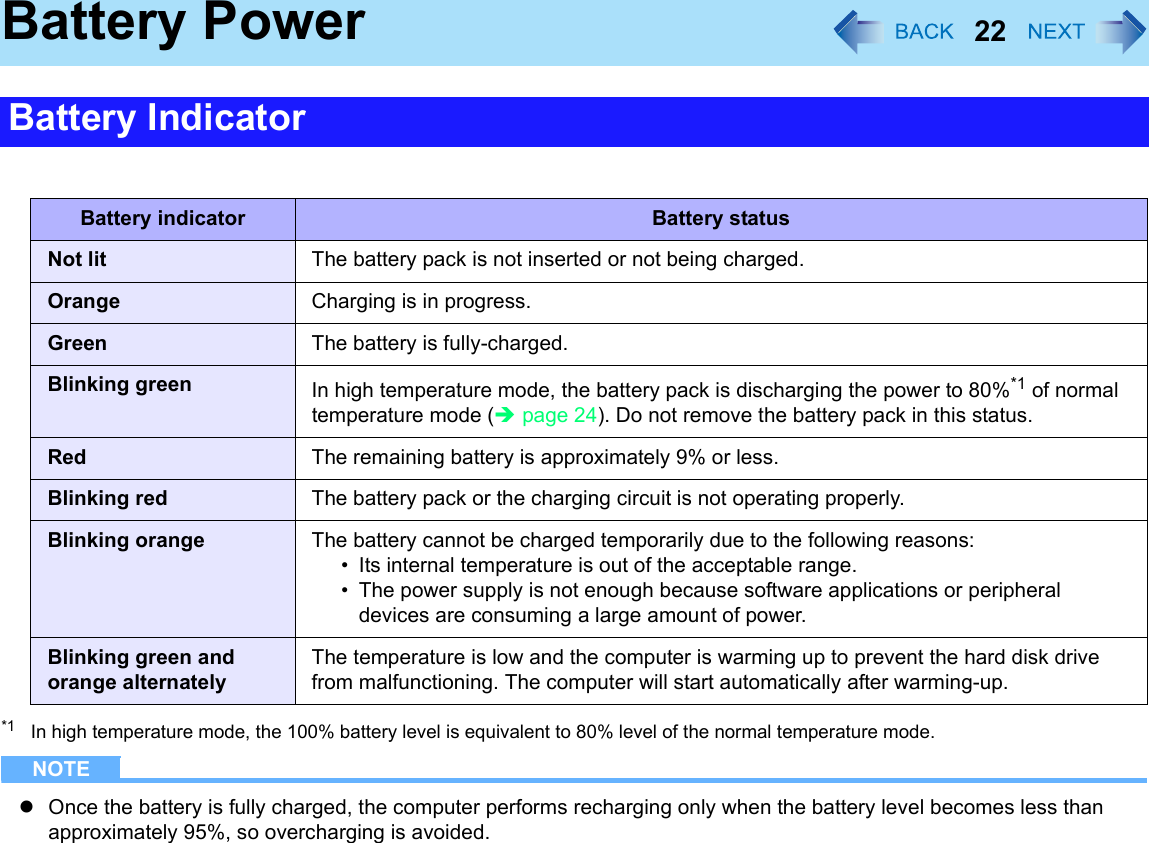
![23Battery PowerYou can check the remaining battery charge on the screen.(After logging on to Windows)1Press Fn+F9. zWhen the battery pack is inserted (example): Normal temperature mode (Îpage 24): High temperature mode (Îpage 24)zWhen the battery pack is not insertedNOTEzThe battery display may not correspond to the actual remaining battery charge in the cases as below. To correct the display, perform the Battery Recalibration (Îpage 26).• The battery indicator remains red.• The indicator lights orange and the display shows 99% for a long time.• Low battery warning appears soon after a short time of use.This can occur when the computer is in standby mode for a long time without power supply from the AC adaptor.zThe battery display may not be the same as that of notification area or of [Power Meter] in [Power Options Properties]. This is not a malfunction.Checking the Remaining Battery Charge](https://usermanual.wiki/Panasonic-of-North-America/9TGCF-198.Reference-Manual-for-CF-19/User-Guide-881153-Page-23.png)
![24Battery PowerHigh temperature modeThe high temperature mode can prevent the battery from deteriorating when the computer is used in high-temperature envi-ronment or used for a long time with its battery fully charged.Select [Auto] (default) or [High Temperature] in [Environment] of the [Main] menu of the Setup Utility (Îpage 67).NOTEzNote that a level corresponding to a 100% charge for high temperature mode is approximately equivalent to an 80% charge level for normal temperature mode.zAfter switching from [Normal Temperature] to [High Temperature] or vice versa, the remaining battery capacity will not be displayed correctly until the battery pack is completely discharged or fully charged.zIn the [Auto] mode:Once the computer has automatically switched from the normal temperature mode to the high temperature mode, the computer will not switch back to the normal temperature mode until the battery has been used and recharged to a total charge level of about five times as much as that of the fully-charged state. This is to avoid battery deterioration.](https://usermanual.wiki/Panasonic-of-North-America/9TGCF-198.Reference-Manual-for-CF-19/User-Guide-881153-Page-24.png)
![25Battery PowerComputer behavior with low batteryThe default settings are as follows.When the battery level becomes 10%[Low battery alarm]When the battery level becomes 5%[Critical battery alarm]zDisplays a message that the battery level is low. zDisplays a message that the battery level is low, and then the computer enters hibernation.↓↓Charge the battery. Connect the AC adaptor or replace the battery to start up the computer.zConnect the AC adaptor immediately. If you do not have the AC adaptor, exit the running programs and Windows, then confirm that the power indicator is off.zIf you have a fully charged spare battery, turn off the computer, replace the battery and turn the computer on again.zConnect the AC adaptor and charge the battery.zIf you have a fully charged spare battery, replace the battery and turn the computer on again.When the computer enters hibernation with the battery down and you resume the operation without charging the battery, Windows may not start up normally or the alarm function may not operate normally from then on.Do not replace the battery pack when the computer is in standby mode.](https://usermanual.wiki/Panasonic-of-North-America/9TGCF-198.Reference-Manual-for-CF-19/User-Guide-881153-Page-25.png)
![26Battery PowerThe “Battery Recalibration” function measures and memorizes the battery capacity. To correct the battery display, use this function to fill the battery and then discharge it completely. Perform the procedure at least once immediately after purchasing the computer. Normally the interval of battery recalibration is three months. The battery display may not be correct when the battery pack deteriorates after a long time use. In this case, perform the procedure again.1Connect the AC adaptor.2Close all the applications.3Perform “Battery Recalibration”.AClick [start] - [All Programs] - [Panasonic] - [Battery] - [Battery Recalibration].BWhen the confirmation message appears, click [Start].zFrequent recalibration of the battery can degrade the battery. A caution message appears when the battery recalibration is performed at the shorter interval than approximately a month. In this case, cancel the battery recalibration.CWhen the message requests shut down of Windows, click [Yes].The battery recalibration starts.After the battery pack is fully charged, discharging starts. When the discharging is completed, the power goes off automatically.After the battery recalibration is finished, normal charging starts.NOTEzThe temperature range should be 10°C to 30°C {50°F to 86°F}.zThe battery recalibration may take a long time due to the large battery capacity. This is not a malfunction.• Full charge: Approximately 4.5 hours [max.]• Complete discharge: Approximately 4.5 hourszIf the computer is turned off during the battery recalibration (e.g., due to power failure, or accidental removal of the AC adaptor and battery pack), the battery recalibration will not be completed.zYou can also perform the battery recalibration with the following procedure.ARestart the computer.BPress F9 while the [Panasonic] boot screen is displayed just after the computer starts the startup procedure.CWhen the remaining battery capacity is displayed, press Enter.DFollow the on-screen instructions.Correcting the Battery Display (Battery Recalibration)](https://usermanual.wiki/Panasonic-of-North-America/9TGCF-198.Reference-Manual-for-CF-19/User-Guide-881153-Page-26.png)
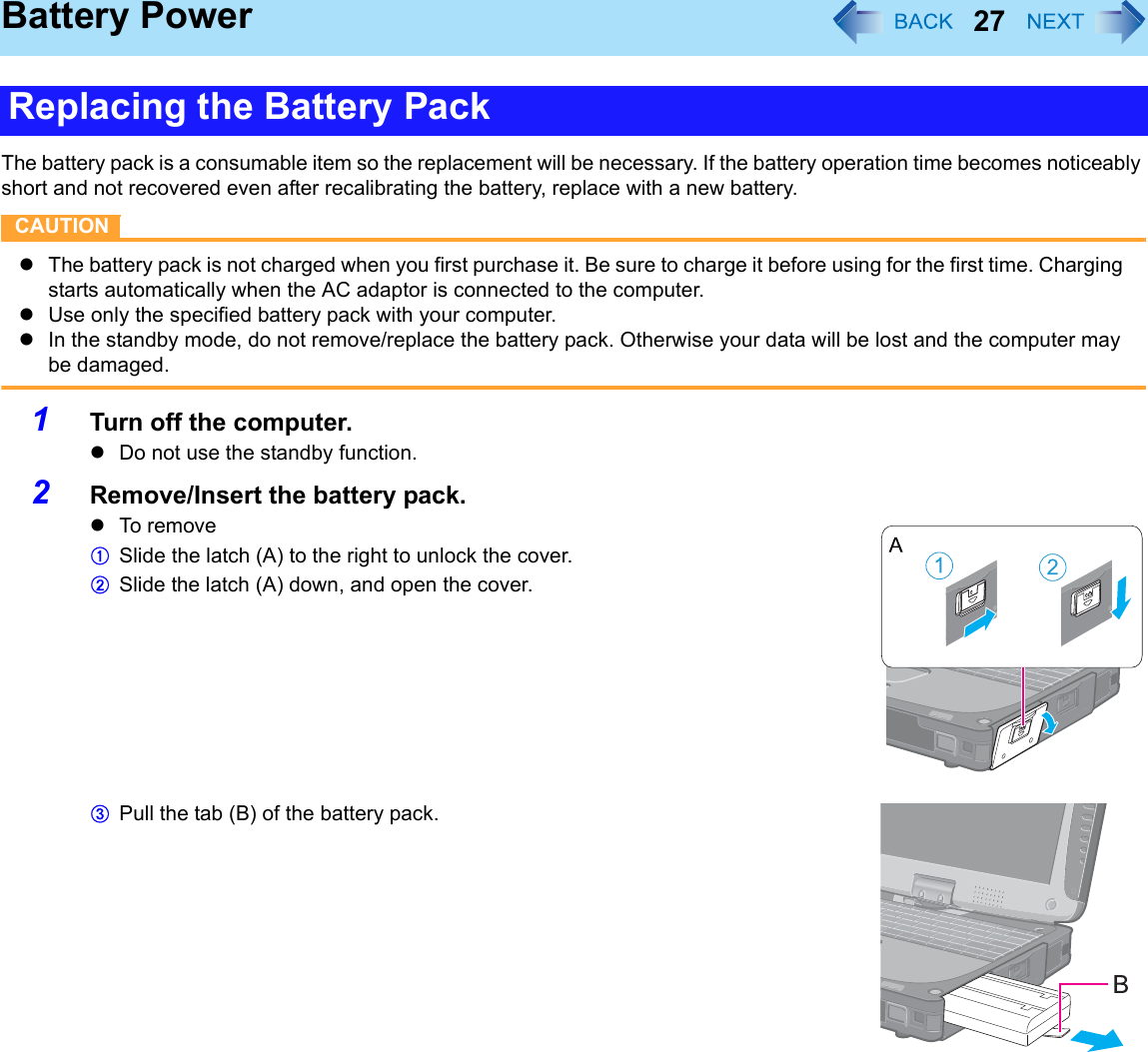
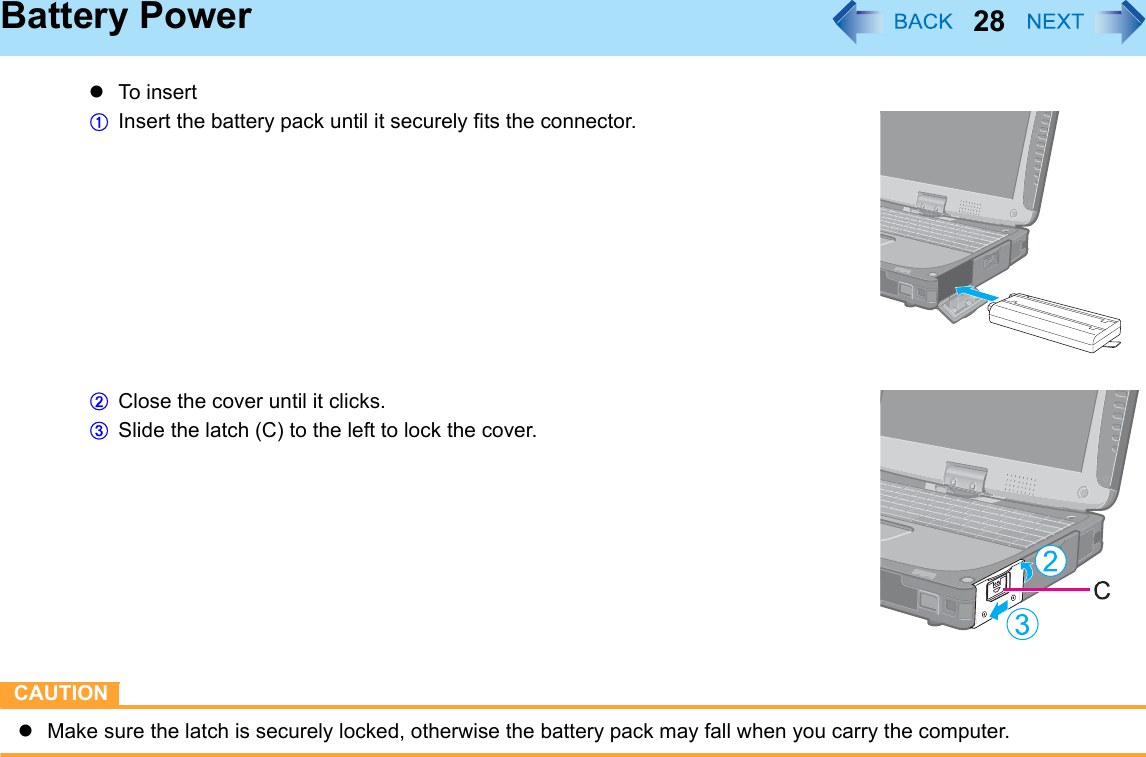
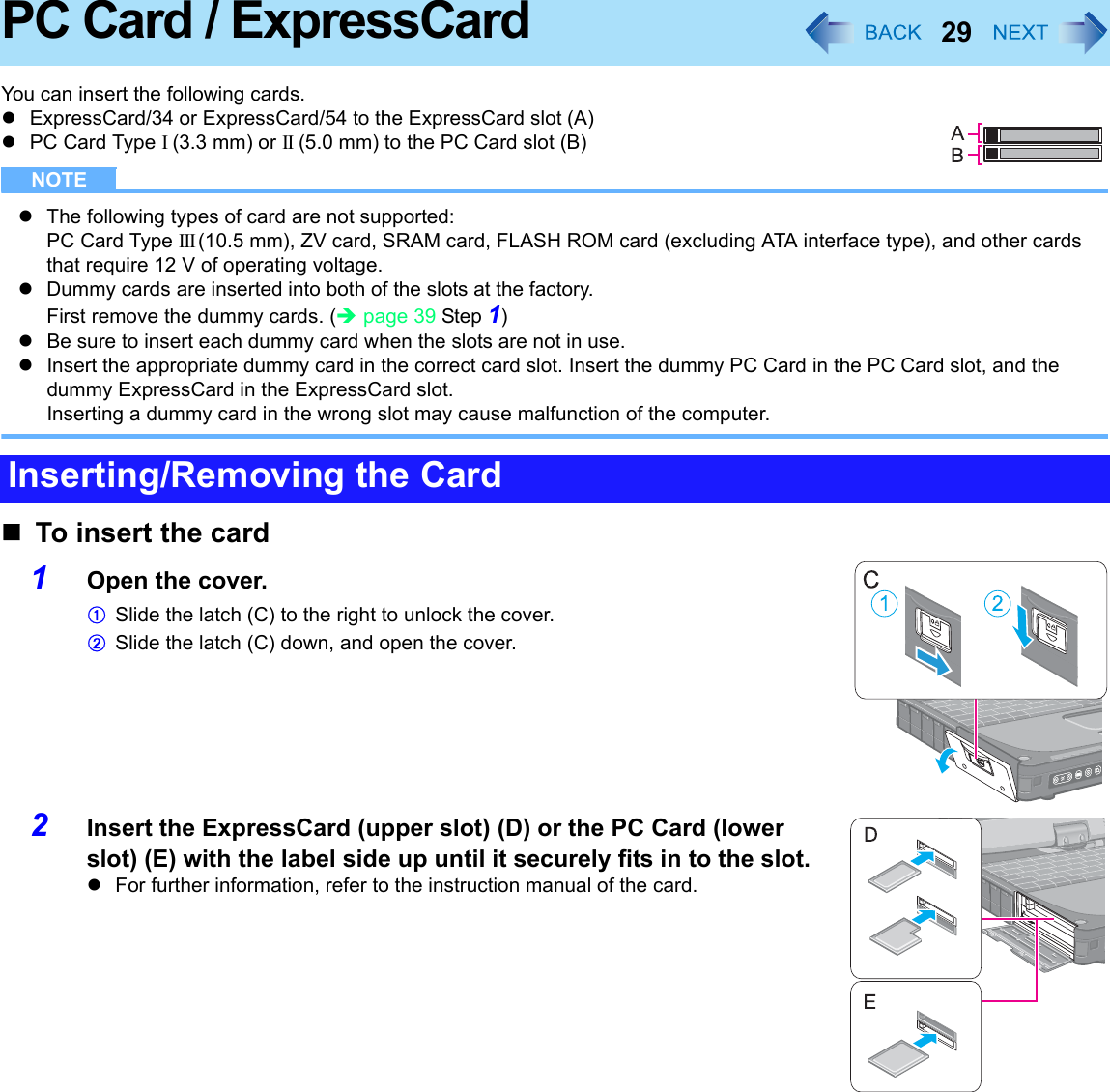
![30PC Card / ExpressCardNOTE<Only for model with Smart Card slot>zThe upper slot (D) is the PC Card slot, and the lower slot (E) is the Smart Card slot. Express Cards cannot be used.For how to insert/remove a Smart Card: Îpage 38To remove the card1Disable the card function.ADouble-click on the notification area and select the card, then click [Stop].BFollow the on-screen instructions.zThis step is not necessary when removing the card after turning off the computer.2Open the cover and remove the card.APress the eject button (F). The eject button pops out.BPress the eject button (F) again so the card comes out of the slot.CDraw the card straight out.NOTEzCheck the card’s specification to prevent the total operating current from exceeding the allowable limit. Otherwise mal-function may occur.Permissible Current: 3.3 V: 400 mA, 5 V: 400 mAzSome types of cards cannot be used simultaneously.zAfter repeating insertion and removal, some types of card will not be recognized. In this case, restart the computer.zIf the computer freezes after resuming from standby or hibernation, remove and reinsert the card. If the problem per-sists, restart the computer.zWhen a card is inserted, power consumption increases. Remove the card when it is not in use, especially when oper-ating by battery power.zTo connect peripheral devices (SCSI, IEEE 1394, etc.) using a PC Card or an ExpressCard, follow the steps below (one example).AConnect the peripheral device to the card.BTurn on the power of device.CInsert the card until it surely fits in the slot.](https://usermanual.wiki/Panasonic-of-North-America/9TGCF-198.Reference-Manual-for-CF-19/User-Guide-881153-Page-30.png)
![31SD Memory CardzThe SD Memory Card has a copyright protection function which is compatible with content on-demand services on the Internet, etc.zTo format the SD Memory Card on this computer, do not use [Format] of Windows, but use the SD Memory Card format software.You can download the software from the web site below.http://panasonic.co.jp/pavc/global/cs/sd/download/sd_formatter.htmlzTo use the SD Memory Card on other devices, format the card on those devices. For further information, refer to the instruction manual of the devices.zThis computer supports SDHC Memory Cards (SD Memory Cards with a capacity of 2 GB or more).Handling and storage cautionszStore the SD Memory Card in the case after removing it from the computer.zDo not:• Disassemble or modify the card.• Hit, bend, or drop the card.• Touch the terminals with fingers or metal object.• Remove the labels of the card / Attach other labels or stickers to the card.zDo not place the card in the following locations.• In direct sunlight or in very hot location such as inside of a car.• In very dusty or humid location.• In location subject to corrosive gas, etc.Data handling cautionszSet the write-protect switch (A) to the LOCK position. Unlock the switch when recording (checkout), saving, or editing data.zWe recommend you to back up the important data to another storage medium.zWhen disposing the card, we recommend you to physically destroy the card (using a ham-mer, etc.) to prevent personal or confidential data leakage.SD Memory Card Information](https://usermanual.wiki/Panasonic-of-North-America/9TGCF-198.Reference-Manual-for-CF-19/User-Guide-881153-Page-31.png)
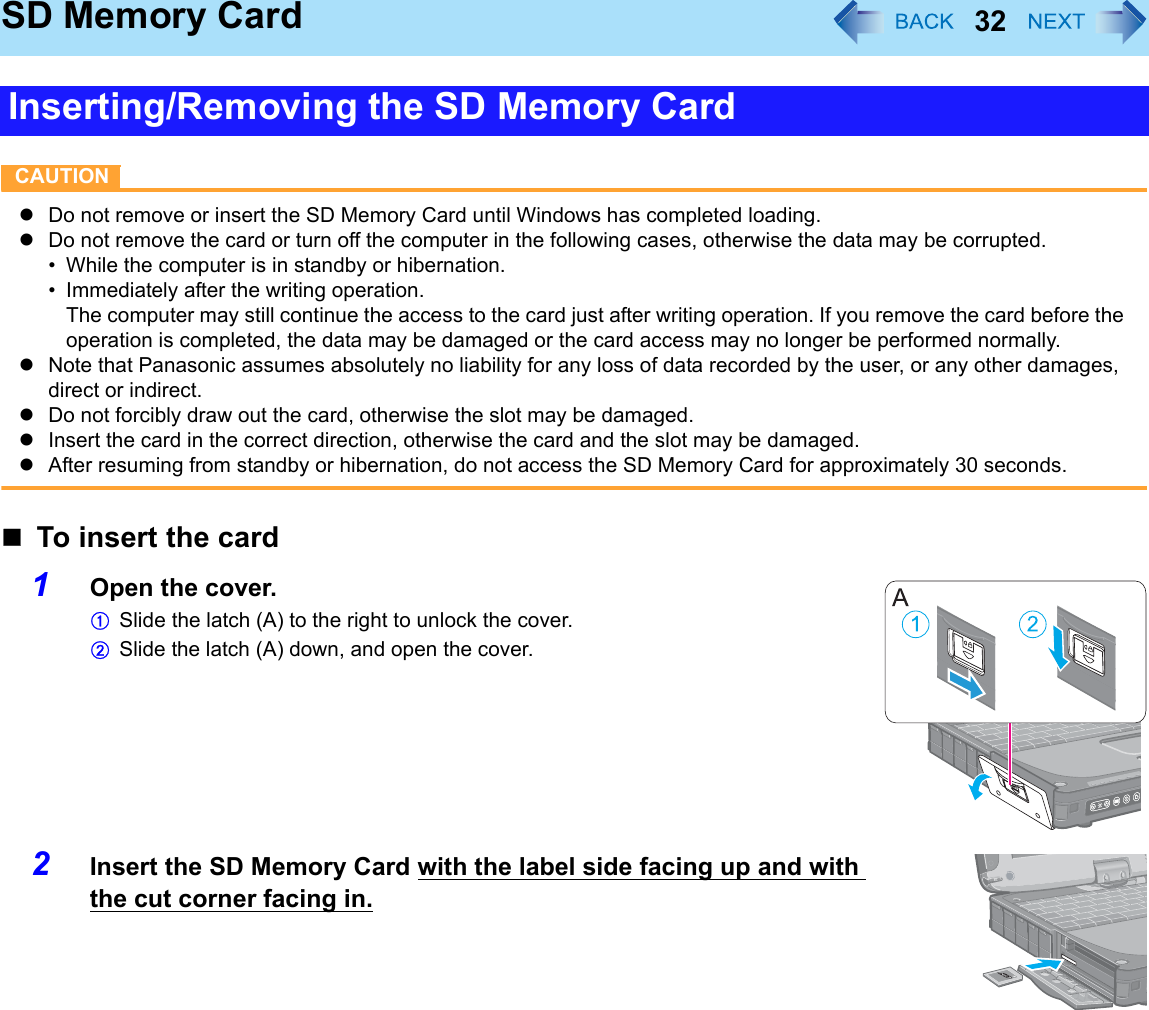
![33SD Memory CardTo remove the cardPreparationzSave the data and close all applications.zOpen the cover and confirm the SD Memory Card indicator (B) is off.1Disable the card function.ADouble-click on the notification area and click [Secure Digital Storage Device], then click [Stop].BFollow the on-screen instructions.zThis step is not necessary when removing the card after turning off the computer.2Remove the card.APress the card so it comes out of the slot. BDraw it straight out.](https://usermanual.wiki/Panasonic-of-North-America/9TGCF-198.Reference-Manual-for-CF-19/User-Guide-881153-Page-33.png)
![34SD SecurityInserting a specific SD Memory Card can work as an alternative to entering password in the cases below. Format the card and make the necessary settings.zStarting up the computerzLogging on to WindowszResuming the computer from standby, hibernation or screensaverNOTEzIf you are unable to use the SD Memory Card, you can enter the Supervisor or User Password to start up the com-puter, then log on to Windows using your logon password.zUse the formatted SD Memory Card (Îpage 31).zThis function works only with the SD Memory Card slot. It does not work with other devices such as the SD card reader/writer connected through USB port.zYou cannot use SDHC Memory Cards (SD Memory Cards with capacities exceeding 2 GB or more) for this function.If an SD Memory Card with a capacity over 2 GB is inserted for this function, an error message will be displayed.zYou can use the setup SD Memory Card as an ordinary card on the computer and other devices.zYou can use a single setup SD Memory Card for multiple computers. However, when using the card to log on to Win-dows, you need to use the same logon user name and the same password on all of the computers.PreparationzTo start up the computer Set the Supervisor Password in the Setup Utility (Îpage 20). (You can also set it during the configuration procedure.)zTo use the card to log on to Windows or to resume from standby, hibernation or screensaverSet the Windows logon user account and the password in [Control Panel] in advance. For further information, refer to the Windows Help.1Log on to Windows as an administrator.2Insert the SD Memory Card in the SD Memory Card slot.If [Secure Digital storage device] appears, click [Take no action], then click [OK].3Start the SD Card Setup program.Click [start] - [All Programs] - [Panasonic] - [SD Card Setup].4Click [Next] in the Welcome screen.SD Card Setup](https://usermanual.wiki/Panasonic-of-North-America/9TGCF-198.Reference-Manual-for-CF-19/User-Guide-881153-Page-34.png)
![35SD Security5Select the trigger operation (A).[Leave set]Insert and leave the card in the slot.(You can remove the card afterward.)[Set and eject]Insert the card and eject.When logging on to Windows or resuming from standby, hibernation or screen-saver, eject the card after the beep sounds to indicate card recognition. If the speakers are muted, beeps do not sound.zMake the setting on each computer. You cannot use different settings on the same computer even with different SD Memory Cards.zTo select different settings for starting the computer and logging on to Windows:In this screen, set the trigger operation to log on to Windows. After completing the SD Card Setup, start the Setup Utility and select the setting to start up the computer in [SD Setting Method] of the [Security] menu (Îpage 70).6Make the necessary settings.To start up the computerThe SD Memory Cards will be registered to the computer.zYou can register up to two cards (To set up the second SD Memory Card: Îpage 36).AAdd the check mark for [Use when starting computer] (B) and click [Next].BClick [Restart the computer after entering settings] and click [Finish].CEnter the Supervisor Password and click [OK].zIf the Supervisor Password is not set, follow the on-screen instructions to set the Supervisor Password.zYou can use up to 32 alphanumeric characters (including spaces).• The case (upper/lower) is ignored.• To input numbers for the password, use the numbered keys on the keyboard.• You cannot use Shift and Ctrl to input a password.To use the card to log on to WindowsThe Windows logon user name and the password set in [Control Panel] are registered in the SD Memory Card.AAdd the check mark for [Use when logging on to Windows] (C) and click [Next].BClick [Restart the computer after entering settings] and click [Finish].CEnter the Windows logon user name and the password.](https://usermanual.wiki/Panasonic-of-North-America/9TGCF-198.Reference-Manual-for-CF-19/User-Guide-881153-Page-35.png)
![36SD SecurityzAfter making this setting, the following functions will be disabled.• Displaying the Welcome screen• The Fast User Switching function• Remote desktop connectionzWhen you add the check mark for [Do not check the user name], you can register the user name that is different from the Windows user name. Click [Yes] at the confirmation message. When restarting the computer and log-ging on to Windows, you will need to enter the Windows user name and the password without using the SD Memory Card.zA [PRIVATE] folder will be created in the SD Memory Card, and the encrypted Windows logon user name and the password will be registered. Do not delete [PRIVATE] folder. Doing so will cancel [Use when logging on to Windows].To use both when starting the computer and when logging on to WindowsAdd the check mark to both [Use when starting computer] and [Use when logging on to Windows], and follow the above steps.CAUTIONzDo not lose the setup card.zDo not leave the setup card in the slot when you go away from the computer.To change the settings / To set up the second SD Memory CardAStart the SD Card Setup program (Îpage 34 Step1-3).The screen is different from the initial setup screen.BChange the settings. [Setting for this computer]You can change the settings registered in this computer.[Setting for this SD card]You can change the settings of the inserted SD Memory Card.CClick [OK].DMake the necessary settings.zRefer to the initial setup procedure above.zYou may need to enter the password to proceed the steps.ERestart the computer.](https://usermanual.wiki/Panasonic-of-North-America/9TGCF-198.Reference-Manual-for-CF-19/User-Guide-881153-Page-36.png)
![37SD SecurityTo disable the setup cardIf you have lost the setup card, disable the card to avoid unauthorized startup or logon.When using the card to start up the computerAStart the SD Card Setup program. (Îpage 34 Step1-3)The current settings will be displayed.BRemove the check mark from [Use the SD card when starting the computer].CClick [OK], and then follow the on-screen instructions.All SD Memory Cards currently registered on this computer will no longer be usable to start up the computer.zEven if you add the check mark again for [Use the SD card when starting the computer], the card will not be usable to start up.When using the card to log on to WindowsAChange the Windows logon password.The card will no longer be usable to log on to Windows.](https://usermanual.wiki/Panasonic-of-North-America/9TGCF-198.Reference-Manual-for-CF-19/User-Guide-881153-Page-37.png)
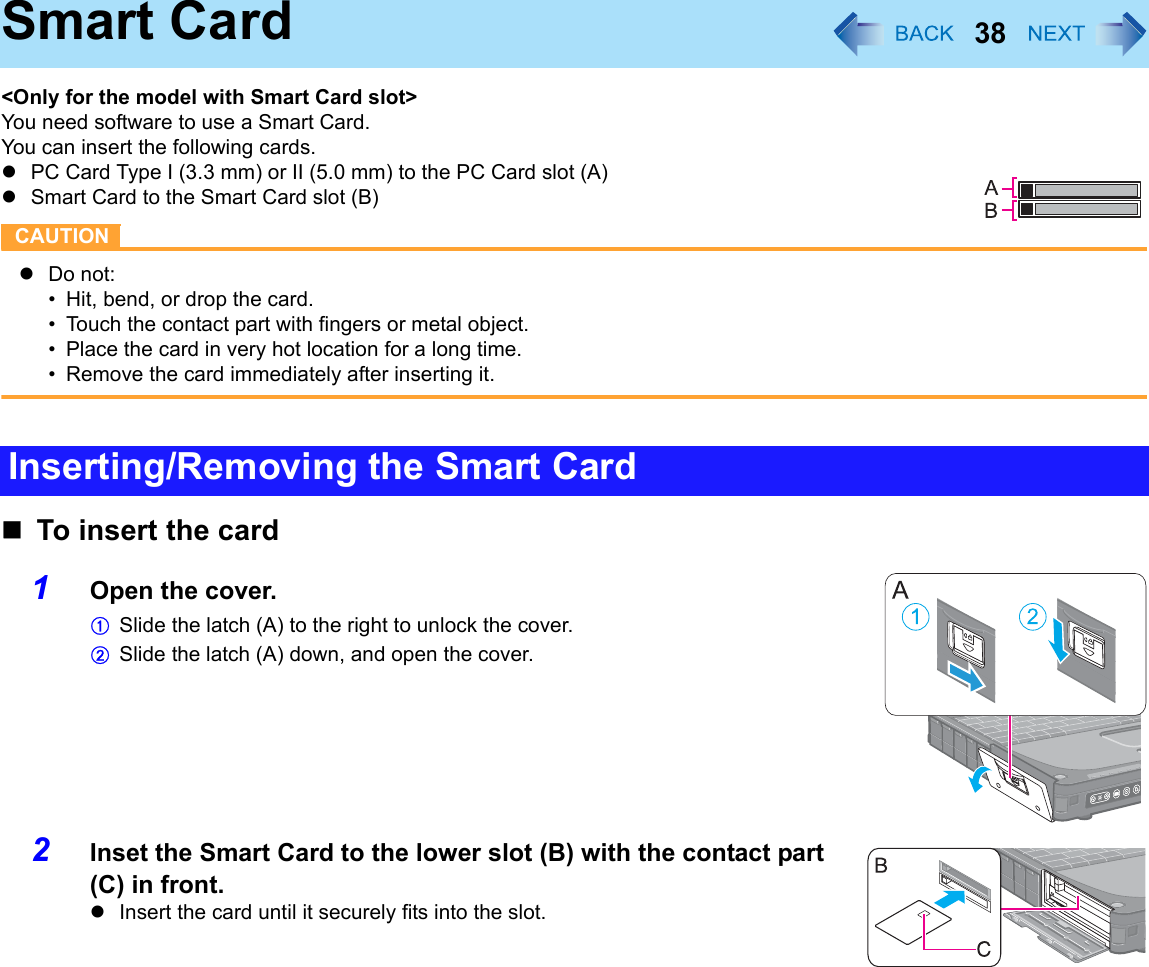
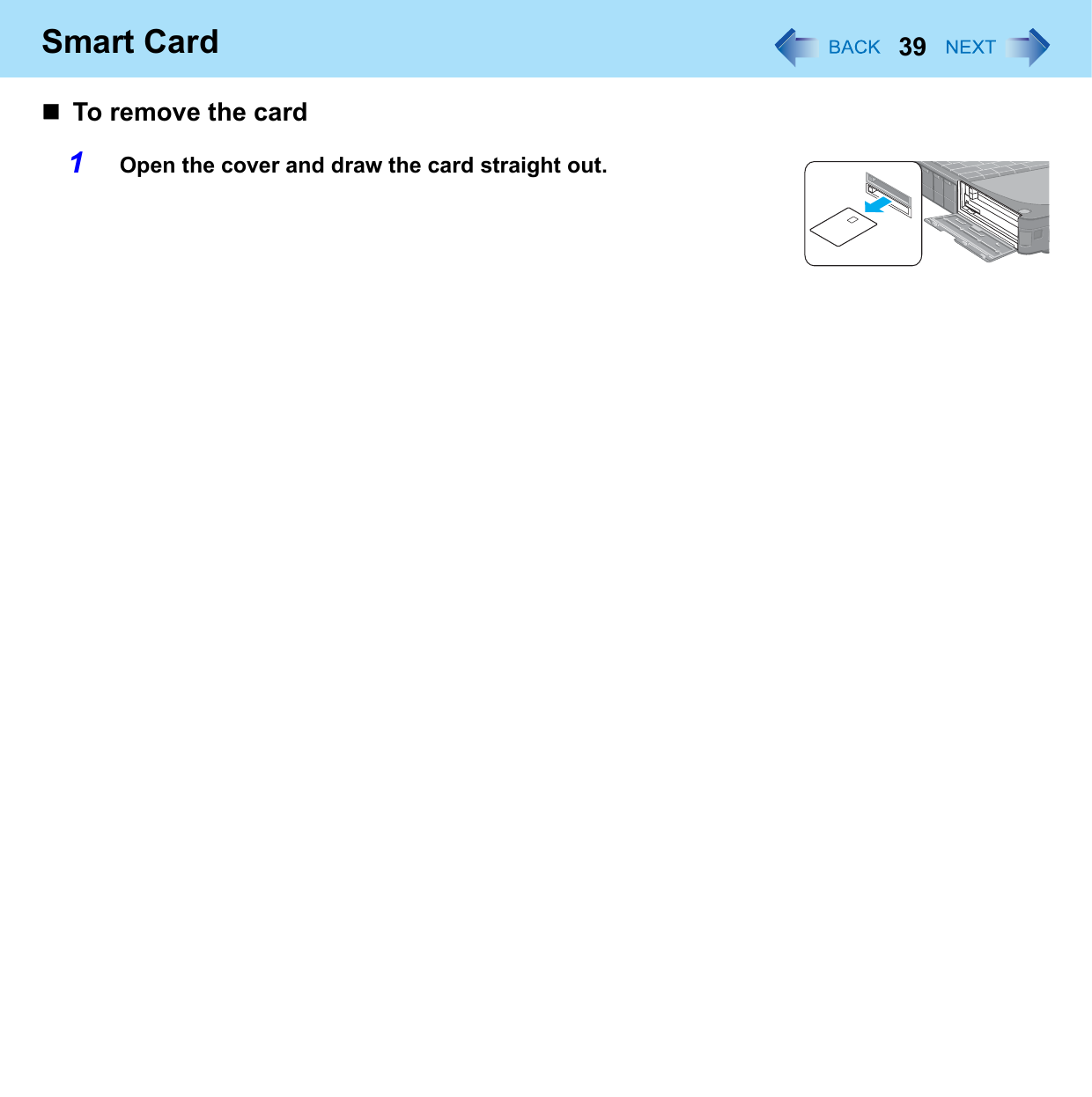
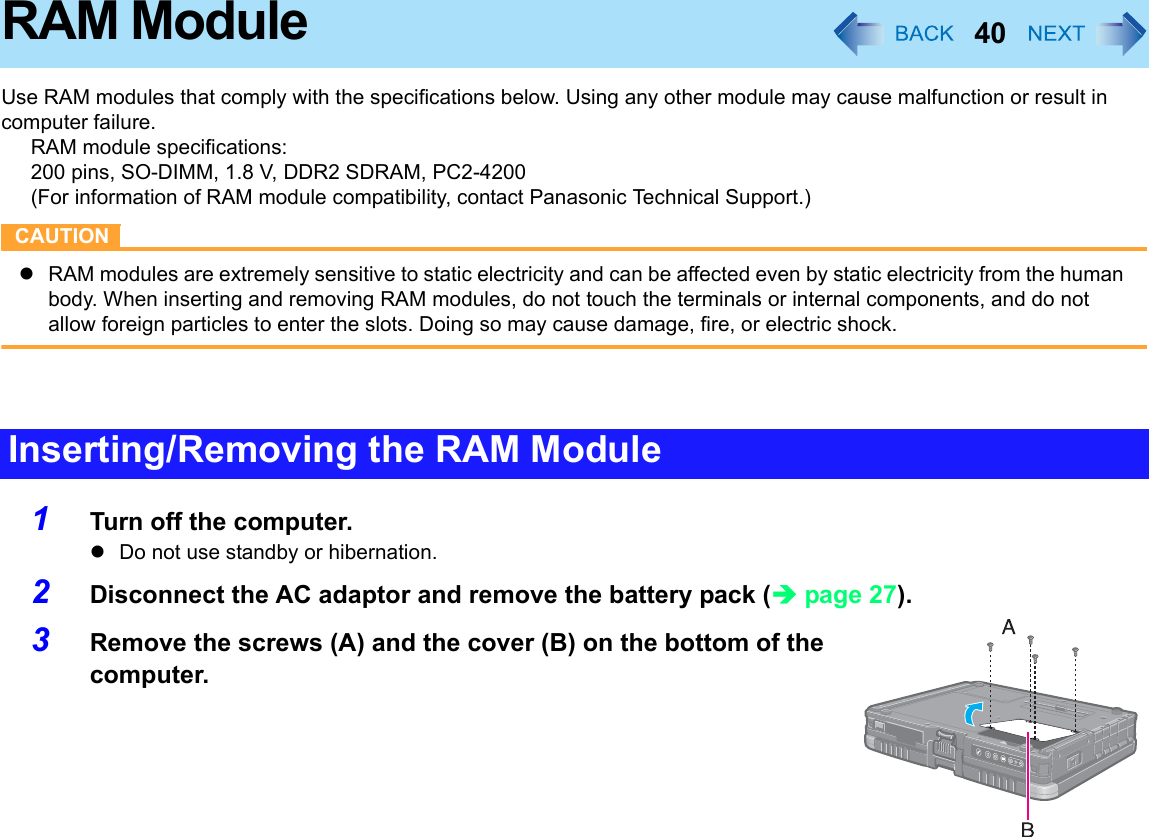
![41RAM Module4Insert/Remove the RAM module.zTo i ns ertATilt the module slightly and insert it in the slot.BPress down the module so that the right and left hooks (C) are locked.zTo r em oveACarefully open the right and left hooks (C).The module will rise.BCarefully remove the module from the slot.5Set the cover and battery pack.NOTEzIf it is hard to insert or to press down the RAM module, do not try forcibly but check the module’s direction.zUse the appropriate screw driver so as not to strip the head of screw.zIf the RAM module is recognized correctly, the total size of the RAM module memory is displayed on the [Information] menu of the Setup Utility (Îpage 66).If the RAM module is not recognized, power off the computer and insert it again.](https://usermanual.wiki/Panasonic-of-North-America/9TGCF-198.Reference-Manual-for-CF-19/User-Guide-881153-Page-41.png)
![42Port Replicator / Car MounterYou can use an optional port replicator and a car mounter. These devices free you from being bothered by a lot of cable connections when you carry the computer. They also allow you to connect various peripherals.Connect the port replicator or the car mounter to the expansion bus connector (A) on the bottom side of the computer.For further information, refer to the instruction manual of the port replicator or the car mounter.CAUTIONzThe driver of the port replicator or the car mounter is preinstalled in the computer. Do not install the driver using the CD-ROM supplied with the port replicator or the car mounter.zMake sure the slide cover is completely open.zHot or warm docking/undocking is not possible with the port replicator or the car mounter.zTo boot the computer from a USB floppy disk drive or a USB CD/DVD drive, be sure to connect the USB drive to the USB port on the computer, not to the USB port on the port replicator or the car mounter.When you connect an external mouse or trackball to the external keyboard/mouse port of the port replicator or the car mounter, some functions of the mouse or trackball (e.g. wheel function) will not work. To use the functions, perform the steps below.After performing the steps below, some of the touch pad functions will not work.NOTEzYou do not need to perform the following steps when using a USB mouse.1Click [start] - [Control Panel] - [Performance and Maintenance] - [System] - [Hardware] - [Device Manager].2Click [Mice and other pointing devices] and double-click [touchpad], and then click [Driver] - [Update Driver].3Click [No, not this time] and click [Next].4Click [Install from a list or specific location (Advanced)] and click [Next].5Click [Don’t search. I will choose the driver to install.] and click [Next].Using an External Mouse](https://usermanual.wiki/Panasonic-of-North-America/9TGCF-198.Reference-Manual-for-CF-19/User-Guide-881153-Page-42.png)
![43Port Replicator / Car Mounter6Click [PS/2 Compatible Mouse] and click [Next].7At the confirmation message, click [Yes].8Click [Finish] and click [Close].9When the message requests restart of Windows, click [Yes].The computer will restart.NOTEzIf you cannot use the functions of the external mouse and trackball even after the steps above, perform the steps below.ATurn off the computer and connect to the port replicator or to the car mounter.BConnect the external mouse or trackball to the port replicator or to the car mounter.CTurn on the computer and start up the Setup Utility (Îpage 65).DSelect the [Main] menu, and set [Touch Pad] to [Disable].EPress F10, and then select [Yes] and press Enter.FLog on to Windows as an administrator.GWhen [Completing the Found New Hardware Wizard] appears, click [Finish].HWhen the message requests restart of Windows, click [Yes].The computer will restart.IInstall the necessary driver following the operating instructions of the connected device.](https://usermanual.wiki/Panasonic-of-North-America/9TGCF-198.Reference-Manual-for-CF-19/User-Guide-881153-Page-43.png)
![44External DisplayYou can switch the output destination to an external display.Connect the external display to the external display port (A).NOTEzAfter resuming from hibernation or restarting the computer, the output destination may not be the same as the selected in the previous status.zWhen you change the display after Windows starts up, do not press any key until switching is complete.zUntil Windows startup is completed (during Setup Utility, etc.), the simultaneous display cannot be used and pressing Fn+F3 switches the display between the internal LCD and the external display.zDisplay switching by pressing Fn+F3 may not work when you use the Fast User Switching function to switch the user. In this case, log off all users and restart the computer.zDisplay switching does not work when [Command Prompt] screen is set to “Full Screen”.zWhen you use the external display only, set the suitable number of colors, resolution, or refresh rate separately from when you use the internal LCD only or when you use the simultaneous display. Depending on the settings, some external displays may be distorted or may not display the mouse cursor correctly. In this case, set the settings to lower value.zWhen you use the simultaneous display, DVD-Video, MPEG files and other motion image files may not be played back smoothly.zCarefully read the instruction manual of the external display. zWhen connecting an external display that does not conform to the Plug & Play standards, select the display driver accordingly in the following menu, or use the driver disk supplied with the monitor.[start] - [Control Panel] - [Appearance and Themes] - [Display] - [Settings] - [Advanced] - [Monitor] - [Properties] - [Driver] - [Update Driver]zIf a picture is not displayed normally, lower the level of [Hardware acceleration] in the following menu.[start] - [Control Panel] - [Appearance and Themes] - [Display] - [Settings] - [Advanced] - [Troubleshoot]CAUTIONzBefore disconnecting the external display, switch to the internal LCD by pressing Fn+F3. Otherwise the displayed image quality may become different after disconnection (e.g., wrong resolution). In this case, press Fn+F3 to reset the image quality.zThe screen may become distorted due to the following operations. In this case, restart the computer.• Disconnecting an external display for which you have set high resolution or high refresh rate.](https://usermanual.wiki/Panasonic-of-North-America/9TGCF-198.Reference-Manual-for-CF-19/User-Guide-881153-Page-44.png)
![45External Display• Connecting/disconnecting an external display during computer operations.1Press Fn+F3.Each time you press the key combination:Internal LCD Simultaneous display External displayThe extended desktop function allows you to use the working area across both the internal LCD and the external display. You can drag an object from the internal LCD to the external display and vice versa.1Display the [Intel(R) Graphics Media Accelerator Driver for mobile] screen.Click [start] - [Control Panel] - [Other Control Panel Options] - [Intel(R) GMA Driver for Mobile] - [Display Devices].2Click [Extended Desktop], and make the settings for [Primary Device] and [Secondary Device].3Click [OK].At the confirmation message, click [OK].NOTEzIt may not be possible to use the extended desktop with some software applications.zWhen you click the maximize button, the window is displayed on one of the displays. You cannot move the maximized window to the other display.zYou cannot switch the display by pressing Fn+F3.zDo not use the display rotation in the extended desktop.zThe popup menu icon displayed by Fn key combination appears only on the primary device.zSet the internal LCD to the primary device when using the touchscreen (only for model with touchscreen) or digitizer (only for model with digitizer). The cursor will move on the primary device when you touch the internal LCD.Switching the DisplayExtended Desktop](https://usermanual.wiki/Panasonic-of-North-America/9TGCF-198.Reference-Manual-for-CF-19/User-Guide-881153-Page-45.png)
![46USB DevicesTo connect the USB device1Open the cover and connect the USB device to one of the USB ports (A).For further information, refer to the instruction manual of the USB device.To remove the USB device1Disable the USB device.ADouble-click on the notification area and select the USB device, then click [Stop].BFollow the on-screen instructions.zThis step is not necessary when;• Removing the device after turning off the computer.• is not displayed.• The device does not appear in the list in step A.2Remove the USB device.NOTEzYou may need to install the driver for the USB device. Follow the on-screen instructions or refer to the instruction man-ual of the USB device.zYou may need to install the driver again when connecting the device to another port.zWhen a USB device is connected, standby and hibernation may not function normally. If the computer does not start up normally, remove the USB device and restart the computer.zWhen the USB device is removed and then inserted, may appear in the Device Manager and the device may not be correctly recognized. In this case, remove and connect the device again.zWhen a USB device is connected, power consumption increases. Remove the USB device when it is not in use, espe-cially when operating by battery power.Connecting/Removing USB Devices](https://usermanual.wiki/Panasonic-of-North-America/9TGCF-198.Reference-Manual-for-CF-19/User-Guide-881153-Page-46.png)
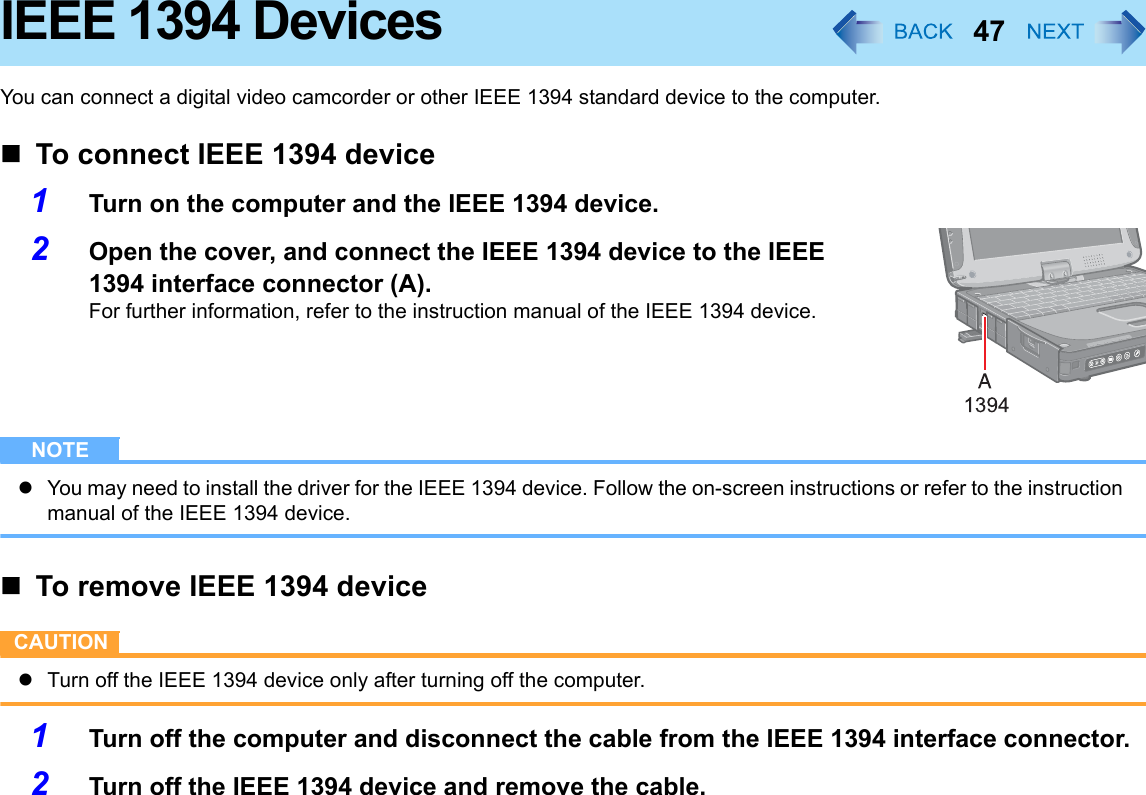
![48Modem<only for model with internal modem>CAUTIONzDo not use the PBX internal phone lines installed in company offices. Doing so may lead to a fire or electric shock.zYou cannot connect the modem to the following lines.• Interphone•Intercoms•ISDNzBe sure to connect the telephone cable into the modem port, not into the LAN port.zUse a surge protector since the modem may be damaged by a sudden high voltage surge that may occur in the event of a lightning strike.1Open the cover and connect the telephone jack (A) to the com-puter by using the telephone cable (included) (B).zHold the cable so that the shape of the connector (C) matches the port, and insert fully until it clicks.2Click [start] - [Control Panel] - [Printers and Other Hardware] - [Phone and Modem Options] and change the settings as neces-sary.NOTEzDo not enter standby or hibernation during communications.zTo remove the cable, press and hold the lever and pull out.Connecting the Internal Modem with a Telephone Jack](https://usermanual.wiki/Panasonic-of-North-America/9TGCF-198.Reference-Manual-for-CF-19/User-Guide-881153-Page-48.png)
![49ModemThe computer automatically resumes from standby when the telephone connected to the modem rings. You will need software to keep the computer in idle state waiting for a phone call, and if you prefer, to turn the computer to standby again afterward. For further information, refer to the instruction manual of the software application.To enable this function1Click [start] - [Control Panel] - [Performance and Maintenance] - [System] - [Hardware] - [Device Manager] - [Modems], and double-click the internal modem.2Click [Power Management], add the check mark for [Allow this device to bring the com-puter out of standby.], and click [OK].To set the time to return the computer to standbyThe computer will enter standby after the set time even when the communication is not completed. You can avoid such an uncompleted communication if you select [Never], but the computer does not return to standby after resuming by a phone call.AClick [start] - [Control Panel] - [Performance and Maintenance] - [Power Options] - [Power Schemes].BSet the expected communication time. NOTEzThis function does not work when the computer is off or is in hibernation.zConnect the AC adaptor.zThe screen remains dark after the computer resumes from standby. The previous screen display will be restored when you touch the keyboard, touch pad, touchscreen (only for model with touchscreen) or tablet buttons. Do not touch the digitizer (only for model with digitizer).zThe computer cannot resume if the telephone is not connected to the internal modem. (e.g., you cannot use a PC Card modem.)zThe computer needs some time to respond, so set the calling time longer than normal. If this is not possible on the transmission side, reduce the number of rings before answering on the software that you are using to keep the com-puter in idle waiting for the call.Ring Resume Function](https://usermanual.wiki/Panasonic-of-North-America/9TGCF-198.Reference-Manual-for-CF-19/User-Guide-881153-Page-49.png)
![50LANCAUTIONzDo not connect the telephone cable to the LAN port.1Turn off the computer.zDo not use standby or hibernation.2Open the cover and connect the cable.Connect the LAN port (A) and the network system (server, HUB, etc.) by using a LAN cable.3Turn on the computer.NOTEzEven when a password is set in the Setup Utility and [Password on boot] is set to [Enable], entering the password is unnecessary for turning on or resuming the computer.zConnect the AC adaptor.zThe Power On by LAN function is off under the following conditions:• When you turn the computer off by sliding the power switch for four seconds or longer (e.g., after a hung-up).• When you reattach the AC adaptor and battery pack to the computer after removing them.zThe screen remains dark after the computer resumes from standby. The previous screen display will be restored when you touch the keyboard, touch pad, touchscreen (only for model with touchscreen) or tablet buttons. Do not touch the digitizer (only for model with digitizer).Connecting LANPower On by LAN/Wake Up from Wired LAN](https://usermanual.wiki/Panasonic-of-North-America/9TGCF-198.Reference-Manual-for-CF-19/User-Guide-881153-Page-50.png)
![51LANEnabling the Power On by LAN functionThe computer automatically turns from off to on when the computer is accessed from the network server via the internal LAN port.1Select [Allow] in [Power On by LAN] in the [Advanced] menu of the Setup Utility (Îpage 69).2In [Caution], press Enter.3Press F10, and then select [Yes] and press Enter.4Log on to Windows as an administrator.5Click [start] - [Control Panel] - [Performance and Maintenance] - [System] - [Hardware] - [Device Manager] - [Network adapters] and double-click [Marvell Yukon 88E8055 PCI-E Gigabit Ethernet Controller], and then click [Advanced].6Click [Wake From Shutdown] in [Property] and select [On] in [Value], and then click [OK].NOTEzThe computer may accidentally turn on if the linkage status is changed. To prevent the accidental startup, make the setting by the following steps.AClick [start] - [Control Panel] - [Performance and Maintenance] - [System] - [Hardware] - [Device Manager] - [Network adapters] and double-click [Marvell Yukon 88E8055 PCI-E Gigabit Ethernet Controller], and then click [Advanced].BClick [Wake Up Capabilities] in [Property] and select [Magic Pocket] in [Value], and then click [OK].Enabling/Disabling the Wake Up from wired LAN functionWhen the Wake Up from wired LAN function is enabled, the computer automatically resumes from standby or hibernation when the computer is accessed from the network server via the internal LAN port. (Default setting)The Wake Up from wired LAN function can be switched to enable/disable by performing the following procedure.1Click [start] - [Control Panel] - [Performance and Maintenance] - [System] - [Hardware] - [Device Manager] - [Network adapters] and double-click [Marvell Yukon 88E8055 PCI-E Gigabit Ethernet Controller], and then click [Power Management].](https://usermanual.wiki/Panasonic-of-North-America/9TGCF-198.Reference-Manual-for-CF-19/User-Guide-881153-Page-51.png)
![52LAN2Add check marks for [Allow the computer to turn off this device to save power.] and [Allow this device to bring the computer out of standby.], and click [OK].We recommend you to make the above two settings ON/OFF simultaneously.NOTEzThe computer may resume when another computer in the network makes unintentional access.Using the following procedure, you can prevent accidental startup by unintentional access.AClick [start] - [Control Panel] - [Performance and Maintenance] - [System] - [Hardware] - [Device Manager] - [Network adapters] and double-click [Marvell Yukon 88E8055 PCI-E Gigabit Ethernet Controller], and then click [Power Management].BAdd a check mark for [Only allow management stations to bring the computer out of standby.], and click [OK].](https://usermanual.wiki/Panasonic-of-North-America/9TGCF-198.Reference-Manual-for-CF-19/User-Guide-881153-Page-52.png)
![53Disabling/Enabling Wireless Communication<Only for model with wireless LAN, Bluetooth and/or wireless WAN>There are three ways of disabling and enabling wireless communication.zThe wireless switch on the left side of the computer (below)zWireless Switch Utility (Îpage 55)zSettings in the [Advanced] menu of the Setup Utility (Îpage 69)NOTEzFor further information about wireless LAN: Îpage 58zFor further information about Bluetooth: Îpage 62zFor further information about wireless WAN: Refer to the instruction manual of the wireless device.zThe wireless communication is also enabled or disabled by connecting or disconnecting the LAN cable. (Îpage 56)To disable all wireless communication1Open the cover.ASlide the latch (A) to the right to unlock the cover.BSlide the latch (A) down, and open the cover.2Slide the wireless switch (B) to OFF.The Wireless Switch](https://usermanual.wiki/Panasonic-of-North-America/9TGCF-198.Reference-Manual-for-CF-19/User-Guide-881153-Page-53.png)
![54Disabling/Enabling Wireless CommunicationNOTEzIf you uninstall the Wireless Switch Utility, set the wireless switch to ON.zDo not turn on/off the switch repeatedly at too short intervals.zDo not restart, log off, or enter standby or hibernation immediately after turning on/off the switch.zDo not turn on/off the switch while Windows is starting up.zTo use wireless communication, set the wireless device ([Wireless LAN] / [Bluetooth] / [Wireless WAN]) to [Enable] (default) in the [Advanced] menu of the Setup Utility (Îpage 69).zWhen you set [Wireless Switch] to [Disable] in the [Advanced] menu of the Setup Utility (Îpage 69), the Wireless Switch Utility icon will not appear in the notification area. All wireless equipment (wireless LAN, Bluetooth, wireless WAN) will remain ready irrespective of the wireless switch setting. zIt may take some time to turn off wireless communication after switching the wireless switch off.zIf the IEEE802.11a setting is changed in [Device Manager] (Îpage 60), the display will be changed accordingly.zYou can check the wireless LAN communication status in Intel® PROSet/Wireless Software. Perform either of the fol-lowing procedures.• Double-click , , , or on the notification area.• Click [start] - [All Programs] - [Intel PROSet Wireless] - [Intel PROSet Wireless].](https://usermanual.wiki/Panasonic-of-North-America/9TGCF-198.Reference-Manual-for-CF-19/User-Guide-881153-Page-54.png)
![55Disabling/Enabling Wireless CommunicationThis utility allows you to control the function of the wireless switch. This utility also allows you to enable or disable wireless devices from a pop-up menu in the notification area. In the default setting, all wireless devices are enabled.The Wireless Switch Utility iconThe icon appears in the notification area. It shows the status of wireless devices.• : Indicates that the wireless devices are enabled.• : Indicates that the wireless devices are off.• : Indicates that the wireless devices have been disabled in the Setup Utility.To enable or disable particular wireless devices1Click the Wireless Switch Utility icon to show the pop-up menu.2Select On or Off for the device you want to enable or disable.To change the function of the wireless switchIn the default setting, the on/off settings that were selected for each device at the time you last turned off the wireless switch are restored when you set the wireless switch to ON again. You can change this function.[Selects the device for which to turn the device status on each time with the dialog box.]Display a dialog each time you set the wireless switch to ON so you can choose which wireless device to enable.[Turns on the following device.]Only selected devices are enabled when you set the wireless switch to ON.[Turns on the device that was on immediately before the wireless switch was turned off the last time.] (default)When you turn on the wireless switch, the on/off settings that were selected when you last turned off the wireless switch will be restored.1Click the Wireless Switch Utility icon ( or ) on the notification area and click [Set-tings...].2Select the setting you want to assign to the wireless switch.3Click [OK].Wireless Switch Utility](https://usermanual.wiki/Panasonic-of-North-America/9TGCF-198.Reference-Manual-for-CF-19/User-Guide-881153-Page-55.png)
![56Disabling/Enabling Wireless CommunicationYou can automatically disable the wireless LAN connection and the wireless WAN connection when a LAN cable is connected to your computer. You need to install the Wireless Connection Disable Utility to use this function.Installing the utility1Log on to Windows as an administrator.2Click [start] - [Run] and input [c:\util\wdisable\setup.exe], and click [OK].3Follow the on-screen instructions to install the Wireless Connection Disable Utility.Checking the status of the wireless connectionNOTEzThe Wireless Switch Utility should also be installed so that the Wireless Connection Disable Utility works. The Wire-less Switch Utility has already been installed at the factory.zTo use the utility, select [Enable] in [Wireless Switch] in the [Advanced] menu of the Setup Utility.zThe utility does not automatically disable the Bluetooth connection.Status indicationAfter installation, the Wireless Connection Disable Utility is automatically started after a user is logged in. An icon appears on the notification area. : Indicates that• the utility is enabled, and• the wireless connection is disabled since a LAN cable is connected. : Indicates that• the utility is enabled, and• the wireless connection is enabled since no LAN cable is connected. : Indicates one of the following statuses;• The utility does not monitor the LAN port status,• the Wireless Switch Utility has not been started, or• the built-in LAN device is not detected or disabled with the device manager.Wireless Connection Disable Utility](https://usermanual.wiki/Panasonic-of-North-America/9TGCF-198.Reference-Manual-for-CF-19/User-Guide-881153-Page-56.png)
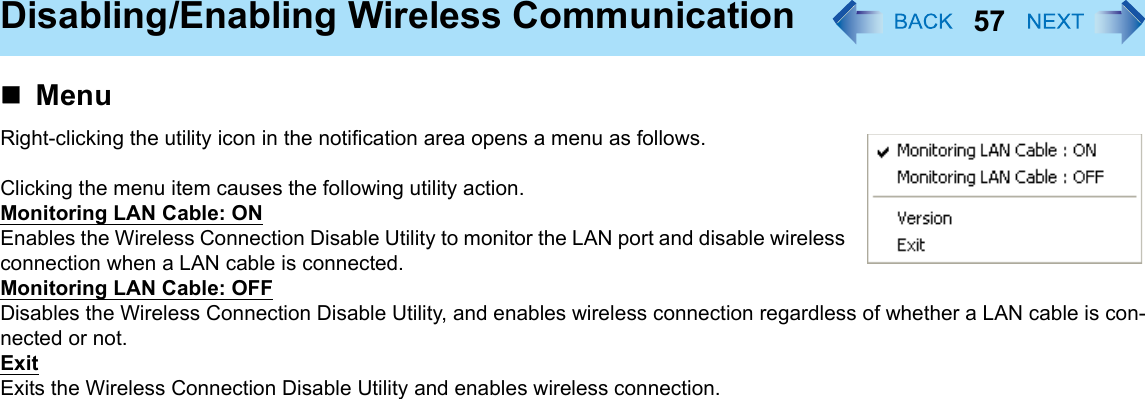
![58Wireless LAN<Only for model with wireless LAN>CAUTIONzDo not use wireless LAN on airplanes, in hospitals, or in other locations where wireless LAN signals may affect peripheral devices.Follow the instructions of airline companies and hospitals. If you use the computer in these locations, turn off the wire-less LAN.zTo avoid unauthorized access to the computer through wireless LANWe recommend you to make security settings such as encryption before using wireless LAN. Otherwise the hard disk data such as the shared files can be exposed to the risk of unauthorized access.NOTEzCommunication is established through the wireless LAN antenna (A). Do not block the antenna area with your hand or body.zYou cannot use the wireless LAN function together with the Fast User Switching function.zThe transmission rate will be lower when a microwave oven is used near by.zTo use wireless LAN, set [Wireless LAN] to [Enable] (default) in the [Advanced] menu of the Setup Utility (Îpage 69).zWireless communication may momently be interrupted when you use the display rotation function in the Tablet mode.To turn on/off wireless LANÎpage 53, Disabling/Enabling Wireless CommunicationTo check the wireless LAN communication statusÎpage 56, Status indication](https://usermanual.wiki/Panasonic-of-North-America/9TGCF-198.Reference-Manual-for-CF-19/User-Guide-881153-Page-58.png)
![59Wireless LAN1Double-click / / on the notification area.The [Intel(R) PROSet/Wireless] screen appears.zWhen or is displayed, skip step 2.2When you double-clicked in step 1, slide the wireless switch to turn on.3Click [Profiles...] at the lower right corner of the window, and click [Add...].4Enter the profile name and wireless network name (SSID), and make other necessary changes, then click [Next].5Make necessary settings and click [OK].6Select the profile you set and click [Connect].7Click [Close].NOTEzYou need to set the profile for each user.zThe settings depend on the network environment. For further information, ask the system administrator or the person in charge of the network.zFor further information of Intel® PROSet/Wireless Software, refer to [Help] in the menu bar.Setting the Profiles](https://usermanual.wiki/Panasonic-of-North-America/9TGCF-198.Reference-Manual-for-CF-19/User-Guide-881153-Page-59.png)
![60Wireless LAN1Click or on the notification area.2Click [802.11a Disabled] or [802.11a Enabled].NOTEzIn some countries, communication using IEEE802.11a (5 GHz wireless LAN) standard is restricted by law.zThe Wireless Switch Utility icon ( or ) indicates the on/off status of wireless LAN and/or Bluetooth and/or wireless WAN, not the setting of IEEE802.11a.zIf IEEE802.11a is enabled or disabled while the computer is connected to an IEEE802.11b/g access point, the connec-tion will be temporarily interrupted.zYou can also change the IEEE802.11a setting in [Device Manager].AClick [start] - [Control Panel] - [Performance and Maintenance] - [System] - [Hardware] - [Device Manager].BDouble-click [Network adapters] and double-click [Intel(R) Wireless WiFi Link 4965AG].CClick [Advanced], and then click [Wireless Mode] in [Property].DRemove the check mark from [Use default value] in [Value], and select the settings (e.g., [802.11a and 802.11g]).EClick [OK].If you turn on/off 802.11a using the popup menu of Wireless Switch Utility, the setting in [Device Manager] will be accordingly changed as below.Enabling/Disabling the Wireless LAN Standard IEEE802.11a (802.11a)Settings in Device Manager Settings in Wireless Switch UtilityWhen 802.11a is enabled When 802.11a is disabled[802.11a, 802.11b and 802.11g] [802.11b and 802.11g] a+b+g is enabled b+g is enabled[802.11g only][802.11a and 802.11g] a+g is enabled g is enabled[802.11a only][802.11b only] a is enabled b is enabled](https://usermanual.wiki/Panasonic-of-North-America/9TGCF-198.Reference-Manual-for-CF-19/User-Guide-881153-Page-60.png)
![61Wireless LANEnabling the Wake Up from Wireless LAN functionThe computer automatically resumes from standby or hibernation when the computer is accessed from the network server via the wireless LAN.1Click [start] - [Control Panel] - [Performance and Maintenance] - [System] - [Hardware] - [Device Manager] - [Network adapters] and double-click [Intel(R) Wireless WiFi Link 4965AG], and then click [Power Management].2Add check marks for [Allow the computer to turn off this device to save power.] and [Allow this device to bring the computer out of standby.], and click [OK].CAUTIONzEven if the Wake Up from wireless LAN function is enabled, it will be disabled once the communication stops for even a moment (for example, when there is heavy signal traffic or the computer is taken out of the communication range of the access point).The Wake Up from wireless LAN function will also be disabled if the wireless switch (Îpage 53) at the ON position is set to OFF.zWhile the Wake Up from wireless LAN function is enabled, the wireless ready LED indicator lights in standby or hiber-nation mode. This does not necessarily mean that the wireless connection is established.NOTEzThe computer may resume when another computer in the network makes unintentional access.Using the following procedure, you can prevent accidental startup by unintentional access.AClick [start] - [Control Panel] - [Performance and Maintenance] - [System] - [Hardware] - [Device Manager] - [Network adapters] and double-click [Intel(R) Wireless WiFi Link 4965AG], and then click [Power Management].BAdd a check mark for [Only allow management stations to bring the computer out of standby.], and click [OK].zIf the wireless switch is set to ON, and the Wake Up from wireless LAN function is enabled, the computer consumes electricity, even in the standby/hibernation mode.zThe Wake Up from wireless LAN function does not work when network connection is established in ad hoc mode.Wake Up from Wireless LAN](https://usermanual.wiki/Panasonic-of-North-America/9TGCF-198.Reference-Manual-for-CF-19/User-Guide-881153-Page-61.png)
![62Bluetooth<Only for model with Bluetooth>You can access internet and other Bluetooth devices without connecting cables.NOTEzCommunication is established through the Bluetooth antenna (A). Do not block the antenna area with your hand or body.zTo use Bluetooth, set [Bluetooth] to [Enable] (default) in the [Advanced] menu of the Setup Utility (Îpage 69).zThe transmission rate will be lower when a microwave oven is used near by.To turn on/off BluetoothÎpage 53, Disabling/Enabling Wireless CommunicationTo check the Bluetooth communication statusÎpage 56, Status indicationTo access the online manualAClick [start] - [All Programs] - [Bluetooth] - [User’s Guide].](https://usermanual.wiki/Panasonic-of-North-America/9TGCF-198.Reference-Manual-for-CF-19/User-Guide-881153-Page-62.png)
![63Hard Disk DriveTo change your hard disk drive, contact Panasonic Technical Support.CAUTIONzBack up all the important data before removing the hard disk drive.zIf you need to read the hard disk data on another computer for repair or any other purpose, set [Hard Disk Lock] to [Disable] in the [Security] menu of the Setup Utility (Îpage 70) before removing the hard disk drive.zCarefully remove/insert the hard disk drive since the hard disk drive is extremely sensitive to shock. Note that static electricity may affect some internal components.1Turn off the computer and disconnect the AC adaptor. zDo not use standby or hibernation.2Remove the battery pack (Îpage 27).3Insert/Remove the hard disk drive.zTo r em oveASlide the latch (A) to the right to unlock the cover.BSlide the latch (A) down, and open the cover.CPull the tab (B) of the hard disk drive and slide it out of the slot.Inserting/Removing the Hard Disk Drive](https://usermanual.wiki/Panasonic-of-North-America/9TGCF-198.Reference-Manual-for-CF-19/User-Guide-881153-Page-63.png)
![64Hard Disk DrivezTo i ns ertAInsert the hard disk drive until it surely fits in the slot.BClose the cover until it clicks, and slide the latch (C) to the left to lock the cover.4Insert the battery pack (Îpage 27).CAUTIONzConfirm that the latch is surely locked so that it does not fall when you carry the computer.NOTEzYou can erase the data before changing the hard disk drive. (⇒ Operating Instructions “Hard Disk Data Erase Utility”)zYou can check that the hard disk is recognized or not in the [Information] menu of the Setup Utility (Îpage 66). If the hard disk is not recognized, turn off the computer and insert it again.](https://usermanual.wiki/Panasonic-of-North-America/9TGCF-198.Reference-Manual-for-CF-19/User-Guide-881153-Page-64.png)
![65Setup UtilityYou can make the settings of the computer’s operating environment (password settings, startup drive selection, etc.)1Turn on or restart the computer.2Press F2 several times while [Panasonic] boot screen is displayed soon after the com-puter starts the startup procedure.When [Enter Password] is displayed, enter your password.When you start the Setup Utility with Supervisor PasswordzYou can make the settings of all items of the Setup Utility.When you start the Setup Utility with User PasswordzNote the following:• In the [Advanced] and [Boot] menus, you cannot make the settings of all items.• In the [Security] menu, you can change only the User Password when [User Password Protection] is set to [No Protection]. You cannot delete the User Password.• In the [Exit] menu, you cannot make the setting of [Get Default Values]. •F9 (Setup Defaults) does not function.Starting the Setup Utility](https://usermanual.wiki/Panasonic-of-North-America/9TGCF-198.Reference-Manual-for-CF-19/User-Guide-881153-Page-65.png)
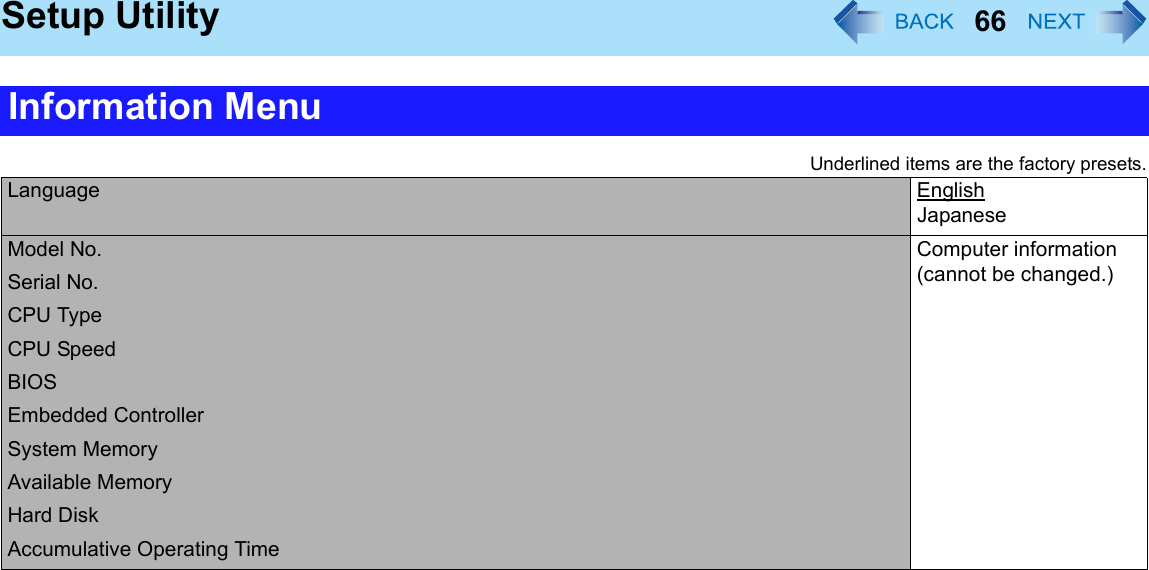
![67Setup UtilityUnderlined items are the factory presets.Main MenuSystem Time• 24-hr. style.• You can use Tab to move the cursor.[xx:xx:xx]System Date• Month/Day/Year.• You can use Tab to move the cursor.[xx/xx/xxxx]Touch Pad DisableEnableTouchscreen Mode• Only for model with touchscreenTouchscreenTabletAutoCurrent Status• Only when [Touchscreen Mode] is set to [Auto].Depending on the touchscreen mode setting, either "Touchscreen" or "Tablet" is displayed.Display• The display during the Windows start-up process. When an external display is not connected, the information appears on the internal LCD even though an [External Monitor] is selected.External MonitorInternal LCDEnvironment Normal TemperatureHigh TemperatureAutoCurrent Status• Only when [Environment] is set to [Auto]. Depending on the battery status, either “Normal Temperature” or “High Temperature” is displayed.](https://usermanual.wiki/Panasonic-of-North-America/9TGCF-198.Reference-Manual-for-CF-19/User-Guide-881153-Page-67.png)
![68Setup UtilityUnderlined items are the factory presets.*1 The submenu that appears when [Serial Port Settings] is selected:Advanced MenuCore Multi-Processing DisableEnableIntel (R) Virtualization Technology DisableEnableXSerial Port Settings• Used to configure the serial port A/B and GPS.Enter the sub-menu*1.Modem• Only for model with internal modemDisableEnableLAN DisableEnableSerial Port A DisableEnableAutoI/O IRQ• Can be changed only when [Serial Port A] is set to [Enable].3F8/IRQ42F8/IRQ33E8/IRQ112E8/IRQ10Serial Port B DisableEnableAutoI/O IRQ• Can be changed only when [Serial Port B] is set to [Enable].3F8/IRQ42F8/IRQ33E8/IRQ112E8/IRQ10GPS• Only for model with GPSDisableEnableAutoI/O IRQ• Can be changed only when [Serial Port A] is set to [Enable].• Can be changed only when [GPS] is set to [Enable].3F8/IRQ42F8/IRQ33E8/IRQ112E8/IRQ10](https://usermanual.wiki/Panasonic-of-North-America/9TGCF-198.Reference-Manual-for-CF-19/User-Guide-881153-Page-68.png)
![69Setup UtilityPower On by LAN• Can be changed only when [LAN] is set to [Enable].• To use [Power On by LAN], make additional settings in [Device Manager] (Îpage 50).DenyAllowWireless LAN• Only for model with wireless LANDisableEnableWireless WAN• Only for model with wireless WANDisableEnableBluetooth• Only for model with BluetoothDisableEnableWireless Switch DisableEnablePC Card Slot DisableEnableExpressCard Slot• Only for model without SmartCard slot• Can be changed only when [Wireless WAN] is set to [Enable].DisableEnableSmart Card• Only for model with Smart Card slotDisableEnableSD Slot DisableEnableIEEE1394 Port DisableEnableUSB Port DisableEnablePort Replicator USB Port• If [Port Replicator USB Port] is set to [Disable], the LAN port of port replicator or the car mounter is also disabled.DisableEnableLegacy USB Support• Can be changed only when [USB Port] or [Port Replicator USB Port] is set to [Enable].DisableEnable](https://usermanual.wiki/Panasonic-of-North-America/9TGCF-198.Reference-Manual-for-CF-19/User-Guide-881153-Page-69.png)
![70Setup UtilityUnderlined items are the factory presets.Security MenuExecute-Disable Bit Capability• [Enable] indicates that this computer supports hardware-based Data Execution Prevention (DEP).DisableEnablePassword on boot DisableEnableSD Startup• Only when [Password on boot] is set to [Enable] and one or more SD card is registered.DisableEnableSD Setting Method• Only when [SD Startup] is set to [Enable]Leave SetSet and EjectXClear registered SD card• Only when one or more SD card is registered.Enter the sub-menu.XSet Supervisor Password Enter the sub-menu.Setup Utility Prompt• When [Setup Utility Prompt] is set to [Disable], the message “Press F2 for Setup / F12 for LAN” is not displayed on [Panasonic] boot screen. However, F2 and F12 will work even if the message is not displayed.DisableEnableBoot First Menu DisableEnableHard Disk Lock DisableEnableUser Password Protection No ProtectionProtectedXSet User Password Enter the sub-menu.XEmbedded Security (TPM) Sub-Menu• Only for model that supports TPMEnter the sub-menu.XComputrace (R) Sub-Menu Enter the sub-menu.](https://usermanual.wiki/Panasonic-of-North-America/9TGCF-198.Reference-Manual-for-CF-19/User-Guide-881153-Page-70.png)
![71Setup Utility*1 Use the Panasonic USB floppy disk drive (optional: CF-VFDU03U)*2 The devices under [Excluded from boot order] are not booted.To change the boot orderTo move up, select the device with Ï and Ð, and then press F6.To move down, select the device with Ï and Ð, and then press F5.To move the device from [Excluded from boot order] to [Boot priority order] or vice versa, select the device with Ï and Ð, and then press X.To return to the default setting, press 1.NOTEzThe default order is [USB FDD] -> [Hard Disk] -> [USB CDD] -> [PCI LAN].zTo boot from the following devices, make the settings as below.zYou can select the boot device during start-up of the computer, too. Press Esc soon after [Panasonic] boot screen is displayed. [Boot Menu] appears and you can select the device. [Boot Menu] appears only when [Boot First Menu] in the [Security] menu is set to [Enable] (Îpage 70). When you change the setting in the [Boot] menu, [Boot Menu] will be changed accordingly.Boot MenuBoot priority order:1: USB FDD:*12: Hard Disk: xxxxxxxxxx3: USB CDD:4: PCI LAN: xxxxxxxxxx5:6:7:8:Excluded from boot order:*2USB KEY:USB HDD:USB LS120:To boot from You need to set• USB connected device : [USB Port] and [Legacy USB Support] to [Enable] (Îpage 69)• LAN : [LAN] to [Enable] (Îpage 68)](https://usermanual.wiki/Panasonic-of-North-America/9TGCF-198.Reference-Manual-for-CF-19/User-Guide-881153-Page-71.png)

![73Icon EnlargerYou can enlarge the screen items such as characters, icons, title bars and cursor.CAUTIONz“Icon Enlarger” will not start up if the display resolution is set lower than 1024 x 768 dots.NOTEzA part of the enlarged menu or some screen items may be hidden. In this case, overlay the cursor to display pop-ups, scroll the screen, or use other functions to display the hidden items.zThe Icon Enlarger setting affects the website characters displayed by Internet Explorer and the e-mail characters in Outlook Express. Some characters of website and e-mail may not be enlarged.PreparationClose all of the applications before using “Icon Enlarger”.1Click [start] - [All Programs] - [Panasonic] - [Icon Enlarger].2Select the size.3Click [OK].The screen will be displayed in the selected size.Enlarging the screen items](https://usermanual.wiki/Panasonic-of-North-America/9TGCF-198.Reference-Manual-for-CF-19/User-Guide-881153-Page-73.png)
![74Loupe UtilityYou can magnify the specific part of the screen.1Click [start] - [All Programs] - [Panasonic] - [Loupe Utility].2Click [OK].z appears on the notification area.1Point the cursor at the part of the screen you want to magnify.2Press and hold Alt, and right-click.zThe part pointed by the cursor is magnified.zAlternatively you can double-click , or right-click and click [Show Loupe].3Drag the loupe window (A) to move the magnified part.zTo hide the loupe window, click the Hide button (B).Alternatively you can click any part out of the loupe window, or press and hold Alt and right-click.zTo change the loupe window size, drag the bottom-right corner (C). The size range you can enlarge/shrink depends on the screen’s resolution.Activating the Loupe UtilityUsing the Loupe Utility](https://usermanual.wiki/Panasonic-of-North-America/9TGCF-198.Reference-Manual-for-CF-19/User-Guide-881153-Page-74.png)
![75Loupe UtilityNOTEzThe magnified text or image in the loupe window is fixed at the moment that the part is magnified (e.g., at the moment you press and hold Alt and right-click). To reflect the change you made on the original screen to the loupe window, click the loupe window.zThe Loupe Utility does not work with some applications.1Right-click on the notification area.2Click [Settings].[Show/hide shortcuts assignment]zWhen using the external mouse/touch padAClick [Mouse/Touch pad]BClick a combination of Alt, Ctrl, and Shift, and add the check mark. (Multiple keys can be combined; for example, Ctrl + Alt)CSelect either [Right click] or [Left Click] to use in combination with the key(s) selected in B above.zWhen using the keyboardAClick [Keyboard].BClick the text box and then press the key used for the shortcut.(e.g., Alt + Z, Ctrl + Alt + Z, etc.)[Window shape]Select the shape of the loupe window.[Autorun]Add a check mark to run the Loupe Utility when Windows starts up.3Click [OK].Setting the Loupe Utility](https://usermanual.wiki/Panasonic-of-North-America/9TGCF-198.Reference-Manual-for-CF-19/User-Guide-881153-Page-75.png)
![76DMI ViewerThis computer conforms to the specifications of the Desktop Management Interface (DMI). You can use the DMI Viewer to access the computer’s information including the CPU, memory and supported system.1Click [start] - [All Programs] - [Panasonic] - [DMI Viewer].The DMI Viewer screen appears.2Click the item to display the detailed information.To save the information as a text fileATo save the item that is displayedClick [File] - [Save Selected Data...].To save all itemsClick [File] - [Save All Data...].BSelect the folder, input the file name, then click [Save].](https://usermanual.wiki/Panasonic-of-North-America/9TGCF-198.Reference-Manual-for-CF-19/User-Guide-881153-Page-76.png)
![77Recover ProRecover Pro is a data backup software application developed by Phoenix Technologies Ltd. It provides 3 types of backup as follows:• Quick Backup: Scheduled backup of the updated data• File Backup: File backup at file save and change• Complete Backup: Backup of the entire data on the internal hard diskFor further information, refer to the software’s online manual.1Log on to Windows as an administrator.2Close all the applications.zDisable antivirus software.3Click [start] - [Run] and input [c:\util\rcvpro\setup.exe], and click [OK].Follow the on-screen instructions.zAfter the computer restarts, Recover Pro starts initialization. Do not touch keys or switch including hot key, during initialization until an instruction message appears.CAUTIONzBe sure to use the internal hard disk drive to create the backup area. Never use disk or device other than the internal hard disk drive.zSome software (security software, backup software, encryption software, or hard disk accessible specific software, etc.) may be incompatible with Recover Pro.For further information, refer to:http://www.phoenix.com/en/Customer+Services/White+Papers-Specs/Recover+Pro/default.htmzWhen using Personal Secure Drive (refer to the Installation Manual of “Trusted Platform Module (TPM)”), do not exe-cute File Backup for Personal Secure Drive.NOTEzIf you select [Typical] in installation, approximately 40% (max.) of the hard disk drive space is allocated as the backup area.zYou cannot change the size of backup area after creation.To access the online manualAClick [start] - [All Programs] - [Phoenix Applications] - [Docs], and double-click [UserGuides].BDouble-click the file of Recover Pro user’s guide or Phoenix Always user’s guide.Installing Recover Pro](https://usermanual.wiki/Panasonic-of-North-America/9TGCF-198.Reference-Manual-for-CF-19/User-Guide-881153-Page-77.png)
![78Technical InformationClose the communications software before using the power saving function.zIf the power saving function (standby or hibernation) is activated while communications software is used, the network con-nection may be interrupted, or the performance may be adversely affected. In this case, restart the computer.zIn a network environment, set the [System standby] and [System hibernates] settings to [Never].Click [start] - [Control Panel] - [Performance and Maintenance] - [Power Options] - [Power Schemes].The Windows files included in the retail version of the Windows CD-ROM for OS are contained in the following folders:<Only for model with Windows XP Professional>c:\windows\docs, c:\windows\dotnetfx, c:\windows\i386, c:\windows\support, c:\windows\valueadd<Only for model with Windows XP Tablet PC Edition>c:\windows\docs, c:\windows\dotnetfx, c:\windows\i386, c:\windows\support, c:\windows\valueadd, c:\windows\cmpnentsThe COM ports of the computer are assigned as below.zCOM1 : Serial Port AzCOM2 : Serial Port B (Port replicator*1/Car mounter*1)zCOM3 : GPS*1*1 OptionalIf you change the assignment, the serial devices may not work properly.Network Connections and Communications SoftwareUsing the Windows Associated FilesSerial Devices](https://usermanual.wiki/Panasonic-of-North-America/9TGCF-198.Reference-Manual-for-CF-19/User-Guide-881153-Page-78.png)
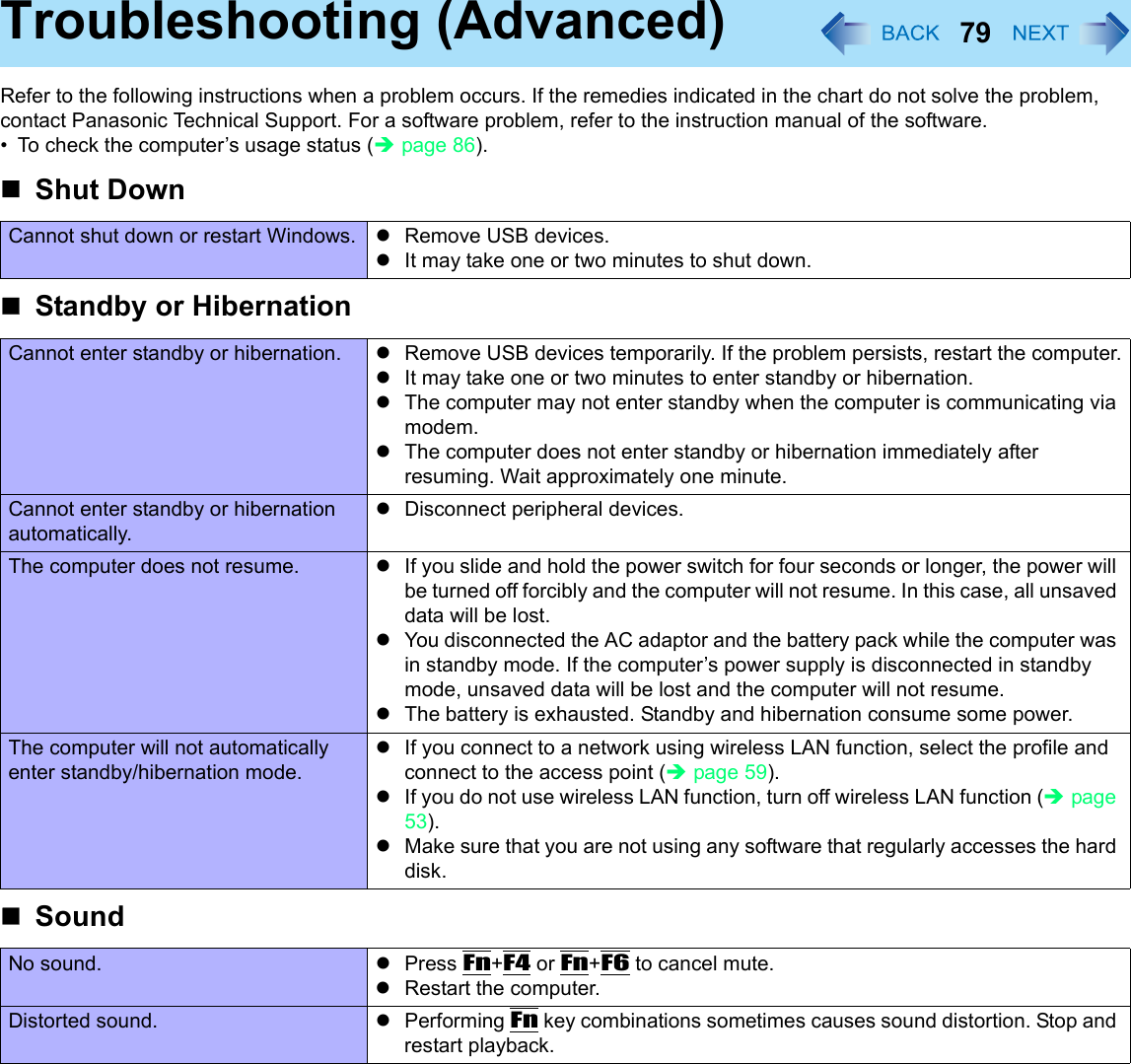
![80Troubleshooting (Advanced)Cannot change the volume by press-ing Fn+F5 or Fn+F6.zActivate the Windows sound function. When it is not active, the volume does not change even if is displayed.“There was an error updating the reg-istry” appears when Sound Recorder is started.zSound Recorder is started by a limited account user whose language setting is not the same as the administrator user who last started Sound Recorder. This does not affect the operation.KeyboardOnly numbers can be input. zWhen the indicator is on, the keyboard is in ten-key mode. Press NumLk to cancel.Only capital letters can be input. zWhen the indicator is on, the keyboard is in Caps Lock mode.Press Caps Lock to cancel.Cannot enter special characters (ß, à, ç, etc.) and symbols.zUse the character map. Click [start] - [All Programs] - [Accessories] - [System Tools] - [Character Map].Cannot use the keyboard in the Tablet mode.z<Only for model with Windows XP Professional>Use the software keyboard. (Îpage 9)z<Only for model with Windows XP Tablet PC Edition>Use the Tablet PC Input Panel. (Refer to the Windows Help.)Display RotationThe display angle does not change automatically when switching Laptop mode and Tablet mode.zSet the default angle correctly for each mode. (Îpage 13)zDo not switch the mode until the Fast User Switching is completed.Cannot rotate the display. zClose all of the applications.zYou cannot rotate the display to 90° and 270° in the Tablet mode if you uninstalled Wireless Switch Utility or Intel® PROSet/Wireless Software. To reinstall, click [start] - [Run] and input [c:\util\wswitch\Setup.exe] (Wireless Switch Utility) / [c:\util\drivers\wlan\XP\Apps\x32\install.bat] (Intel® PROSet/Wireless Software), and click [OK]. Then restart the computer.The operations of touch pad and touchscreen (only for model with touchscreen) do not match the rotation angle.zThe operations do not match immediately after you start Windows.zClose the applications and press the Rotation button until the operations match the rotation angle. The operations do not match in some applications or when you change the screen settings in [Display Properties] or Intel(R) GMA Driver for Mobile with the display rotated.Sound](https://usermanual.wiki/Panasonic-of-North-America/9TGCF-198.Reference-Manual-for-CF-19/User-Guide-881153-Page-80.png)
![81Troubleshooting (Advanced)NetworkCannot connect to network. zSet [LAN], or [LAN] and [Modem] to [Enable] in the [Advanced] menu of the Setup Utility (Îpage 68).Cannot check the computer’s MAC address.zFollow the steps below.AClick [start] - [All Programs] - [Accessories] - [Command Prompt].BInput [ipconfig/all], and press Enter.CWrite down the 12-digit string of alphanumeric displayed in the “Physical Address” line of the LAN or the wireless LAN (only for model with wireless LAN).DInput [exit], and press Enter.Wireless Communication (only for model with wireless LAN/Bluetooth/wireless WAN)Cannot connect to network. zSlide the wireless switch to turn on the wireless devices.zSet the devices ([Wireless LAN] / [Bluetooth] / [Wireless WAN]) to [Enable] in the [Advanced] menu of the Setup Utility (Îpage 69).zDisable the Wireless Connection Disable Utility.zRestart the computer.zYou cannot turn on wireless LAN if you uninstalled Display Rotation Tool.To reinstall it, click [start] - [Run] and input [c:\util\disprot\Setup.exe], and click [OK].Access point is not detected. zConfirm that / / is displayed on the notification area.If / / is not displayed on the notification area, turn on the wireless communication (Îpage 53).Connecting PeripheralsAn error occurs while installing the driver.zWhen you install a driver of card or peripheral device, make sure that the driver is compatible with the operating system. If it is not compatible, malfunction may occur. For information about the driver, contact the manufacturer of the peripheral device.](https://usermanual.wiki/Panasonic-of-North-America/9TGCF-198.Reference-Manual-for-CF-19/User-Guide-881153-Page-81.png)
![82Troubleshooting (Advanced)A peripheral device does not work. zInstall the driver.zContact the manufacturer of the device.zWhen operation resumes from standby or hibernation, devices such as a mouse, modem and PC Card may not function properly. In this case, restart the computer or reinitialize the device.zWhen is displayed in the Device Manager, remove and insert the device. If the problem persists, restart the computer.zThe computer may not recognize the connection/removal of some devices, or may not operate normally with some devices.AClick [start] - [Control Panel] - [Performance and Maintenance] - [System] - [Hardware] - [Device Manager].BSelect the device and remove the check mark for [Allow the computer to turn off this device to save power.] in [Power Management]. (This item may be unavailable for some types of devices.)The connected mouse does not work. zCheck the mouse connection.zInstall the driver compatible with the connected mouse.If the mouse does not work even after installing the driver, set [Touch Pad] to [Disable] in the [Main] menu of the Setup Utility (Îpage 67).USB floppy disk drive does not work as a boot drive.zYou can use only the Panasonic CF-VFDU03U USB floppy disk drive (optional).zConnect the floppy disk drive directly to a USB port of the computer. Do not connect it via a USB hub or USB connector of the port replicator or the car mounter. If you have connected to a USB port on the computer, try connecting it to one of the other USB ports.zSet [USB Port] and [Legacy USB Support] to [Enable] in the [Advanced] menu of the Setup Utility (Îpage 69).zMove up [USB FDD] to the top of [Boot priority order] in the [Boot] menu of the Setup Utility (Îpage 71).zTurn off the computer and connect the USB floppy disk drive, and then restart the computer.The RAM module is not recognized. zInsert the RAM module correctly.zUse the compatible RAM module (Îpage 40).zCheck the [Information] menu in the Setup Utility (Îpage 66). If the RAM module is not recognized, turn off the computer and reinsert the RAM module.You do not know the address map for IRQ, I/O port address, etc.zTo check the current address map, click [start] - [Control Panel] - [Performance and Maintenance] - [System] - [Hardware] - [Device Manager] - [View] - [Resources by type].Connecting Peripherals](https://usermanual.wiki/Panasonic-of-North-America/9TGCF-198.Reference-Manual-for-CF-19/User-Guide-881153-Page-82.png)
![83Troubleshooting (Advanced)The device connected to the serial port does not work.zCheck the connection.zThe device driver may not work. Refer to the instruction manual of the device. zDo not connect two mouse devices simultaneously.zSet [Touch Pad] to [Disable] in the [Main] menu of the Setup Utility (Îpage 67).zSet [Serial Port A] or [Serial Port B] to [Auto] in the submenu of [Serial Port Settings] in the [Advanced] menu of the Setup Utility (Îpage 68).zThe I/O and IRQ you can use vary depending on the device. If the setting does not work, try other settings in the Setup Utility.The Serial Port B of the port replicator or the car mounter does not work.zSet [Serial Port B] to [Auto] in the submenu of [Serial Port Settings] in the [Advanced] menu of the Setup Utility (Îpage 68).Cannot print. zCheck the printer connection.zTurn on the printer.zThe printer is not online.zNo paper is in the printer tray or there is a paper jam.zTurn on the printer and connect it to the computer, and then restart the computer.LAN transmission speed slows down noticeably.Poor performance during data trans-mission via a PC Card (e.g., distorted video image when writing to a DV camera using an IEEE1394 PC Card).<Only for model with wireless LAN>Wireless LAN connection is cut.zThese problems may occur due to performance loss that results from the CPU power-saving function. Log on to Windows as an administrator and follow the steps below.AClick [start] - [Run] and input [c:\util\cpupower\setup.exe], and click [OK].Follow the on-screen instructions.BClick [start] - [All Programs] - [Panasonic] - [CPU Idle Setting].CClick [Performance] and click [OK], then click [Yes].The computer will restart.zIf the problem persists, click [start] - [Control Panel] - [Performance and Maintenance] - [Power Options] - [Power schemes], select [Always On] in [Power schemes], and click [OK].• The above remedy is effective for performance loss resulting from the CPU power saving function, but not for other causes (e.g., noise generated by high CPU load such as video playback).• The above remedy slightly reduces the battery operation time. Normally it is recommended to select [Battery (Windows XP Standard)] in [CPU Idle Setting] and to select [Portable/Laptop] in [Power schemes].Connecting Peripherals](https://usermanual.wiki/Panasonic-of-North-America/9TGCF-198.Reference-Manual-for-CF-19/User-Guide-881153-Page-83.png)
![84Troubleshooting (Advanced)Touch Pad / Touchscreen (only for model with touchscreen)/Digitizer (only for model with digitizer)The cursor does not work. zConnect the external mouse correctly.zRestart the computer using the keyboard. (Press , U, and R to select [Restart].)zIf the computer does not respond to keyboard commands, read “No response” (Îpage 85).Cannot input using the touch pad. zSet [Touch Pad] to [Enable] in the [Main] menu of the Setup Utility (Îpage 67).zThe touch pad may be disabled by some mouse drivers. Check your mouse’s operating instructions.Cannot point the correct position using the included stylus/pen.z<Only for model with touchscreen>Perform the touchscreen calibration (Îpage 7).z<Only for model with digitizer>Perform the digitizer calibration (Îpage 8).PC Card / ExpressCardA card does not work. zInsert the card correctly.zThe card does not conform to the card standard.zRestart the computer after installing a driver (of card or other device).zSet [PC Card Slot] and [ExpressCard Slot] to [Enable] in the [Advanced] menu of the Setup Utility (Îpage 69).zThe port settings are not correct.zRead the instruction manual of the card or contact the manufacturer of the card.zRemove the card and insert it again (Îpage 29).zThe driver is not compatible with the operating system.SD Memory CardCannot use an SD Memory Card. zSet [SD Slot] to [Enable] in the [Advanced] menu of the Setup Utility (Îpage 69).Cannot use SD security function. zSetup the SD Memory Card (Îpage 34).Cannot log on using the SD Memory Card.zThe user name and password set in the SD Memory Card are not correct.Enter the correct user name and password, and log on to Windows without using the SD Memory Card. Set the correct user name and password in [SD Card Setup] (Îpage 34).](https://usermanual.wiki/Panasonic-of-North-America/9TGCF-198.Reference-Manual-for-CF-19/User-Guide-881153-Page-84.png)
![85Troubleshooting (Advanced)Fast User Switching FunctionSome applications do not work prop-erly.zWhen switching to a different user with the Fast User Switching function, the following problems may occur.• Some applications may not work properly. • Key combination with Fn may not work.• The display settings may not be possible.• A serial mouse may not work.• <Only for model with wireless LAN>Wireless LAN cannot be used.• <Only for model with Bluetooth>Bluetooth cannot be used.In these cases, log off all users without using Fast User Switching function and perform the operation once more. If the problem persists, restart the computer.OthersNo response. zPress Ctrl+Shift+Esc to open Task Manager and close the software application.zAn input screen (e.g., password input screen at startup) may be hidden behind another window. Use Alt+Tab to check.zShut down by sliding and holding the power switch for four seconds or longer, and turn on the computer and open the application again. If it no longer works normally, delete and reinstall it.Click [start] - [Control Panel] - [Add or Remove Programs].](https://usermanual.wiki/Panasonic-of-North-America/9TGCF-198.Reference-Manual-for-CF-19/User-Guide-881153-Page-85.png)
![86Troubleshooting (Advanced)You can check the computer’s usage status in the PC Information Viewer. You may need this information when calling Panasonic Technical Support for advice. NOTEzThis computer periodically records the management information including the hard disk information such as number of hours powered-on, number of times powered-on, internal temperature, replacement sector. The maximum data vol-ume for each record is 750 byte. These information are only used for estimating the cause when the hard disk goes down by any possibility. They are never sent to outside via network nor used for any other purpose except for the pur-pose described the above.To disable the function, add the check mark for [Disable the automatic save function for management information his-tory] in [Hard Disk Status] of PC Information Viewer, and click [OK].zIf you have not logged on with the administrator authority, some information will be displayed as [Not Found].zAs long as it is activated, the PC Information Viewer will appear in front of all other screens.1Click [start] - [All Programs] - [Panasonic] - [PC Information Viewer] - [PC Information Viewer]. 2Select the item to display the detailed information.To save the information as a text fileADisplay the information you want to save.BClick [Save].CSelect the file save range option and click [OK].DSelect the folder to save the information, input the file name, and click [Save]. zIf automatic saving of the management information record has not been disabled, the records already recorded are also saved.To save a copy of the screen as an image fileADisplay the screen you want to save.BPress Ctrl+Alt+F8.CWhen the screen copy message appears, click [OK].The screen image is saved in [My Documents] folder.zAlternatively you can save a copy of the screen in the following procedure.Click [start] - [All Programs] - [Panasonic] - [PC Information Viewer] - [Screen Copy]. Checking the Computer’s Usage Status](https://usermanual.wiki/Panasonic-of-North-America/9TGCF-198.Reference-Manual-for-CF-19/User-Guide-881153-Page-86.png)
![87Troubleshooting (Advanced)NOTEzThe image is a bitmap file in 256 colors.zWhen using the extended desktop (Îpage 45), a copy of the primary device screen is saved.zThe default key combination to copy is Ctrl+Alt+F8. You can change it in the following procedure.ALog on to Windows as an administrator, and click [start] - [All Programs] - [Panasonic] - [PC Information Viewer].BRight-click [Screen Copy] - [Properties] and click [Shortcut].CClick [Shortcut key] and press the key(s) you want to use for the shortcut.DClick [OK].](https://usermanual.wiki/Panasonic-of-North-America/9TGCF-198.Reference-Manual-for-CF-19/User-Guide-881153-Page-87.png)
